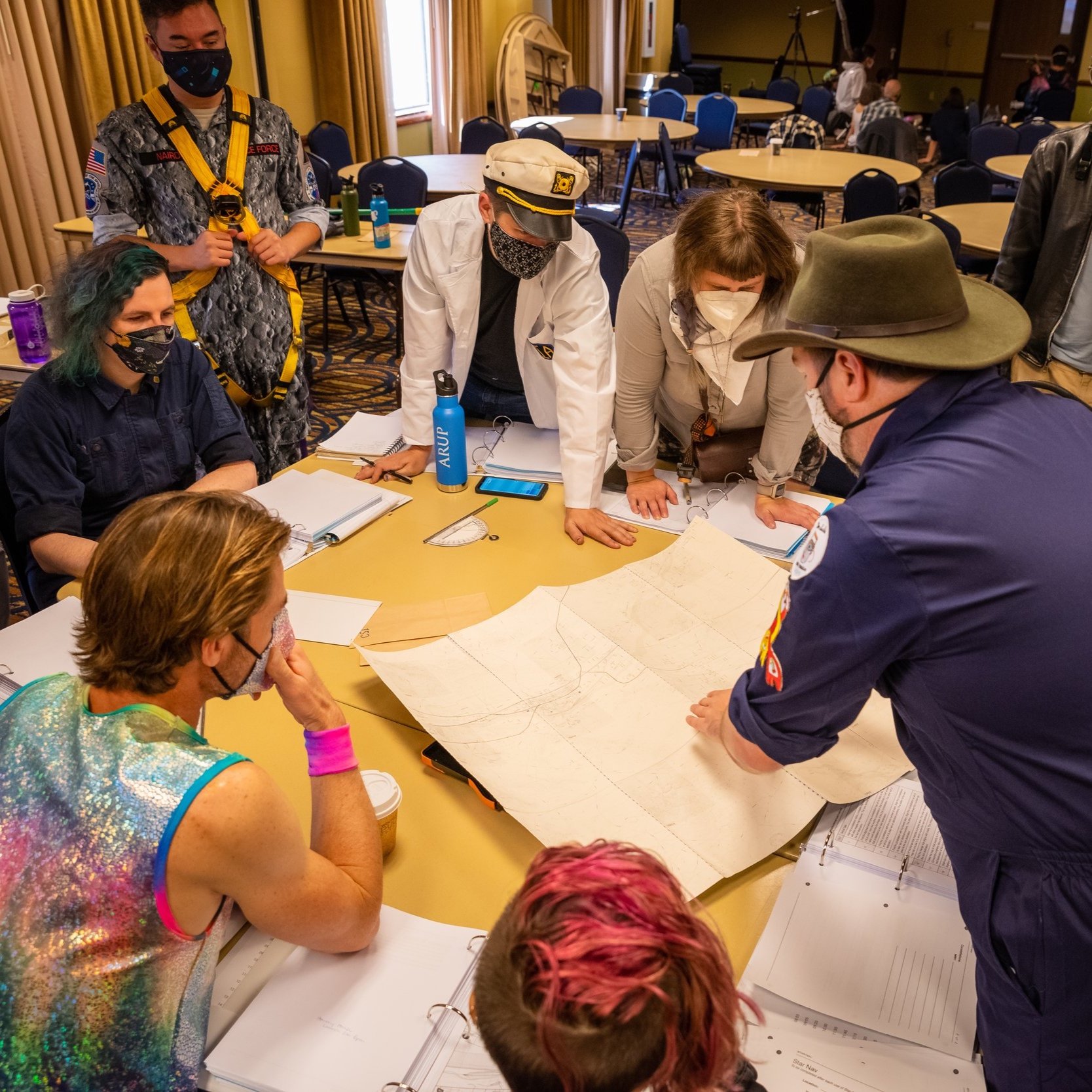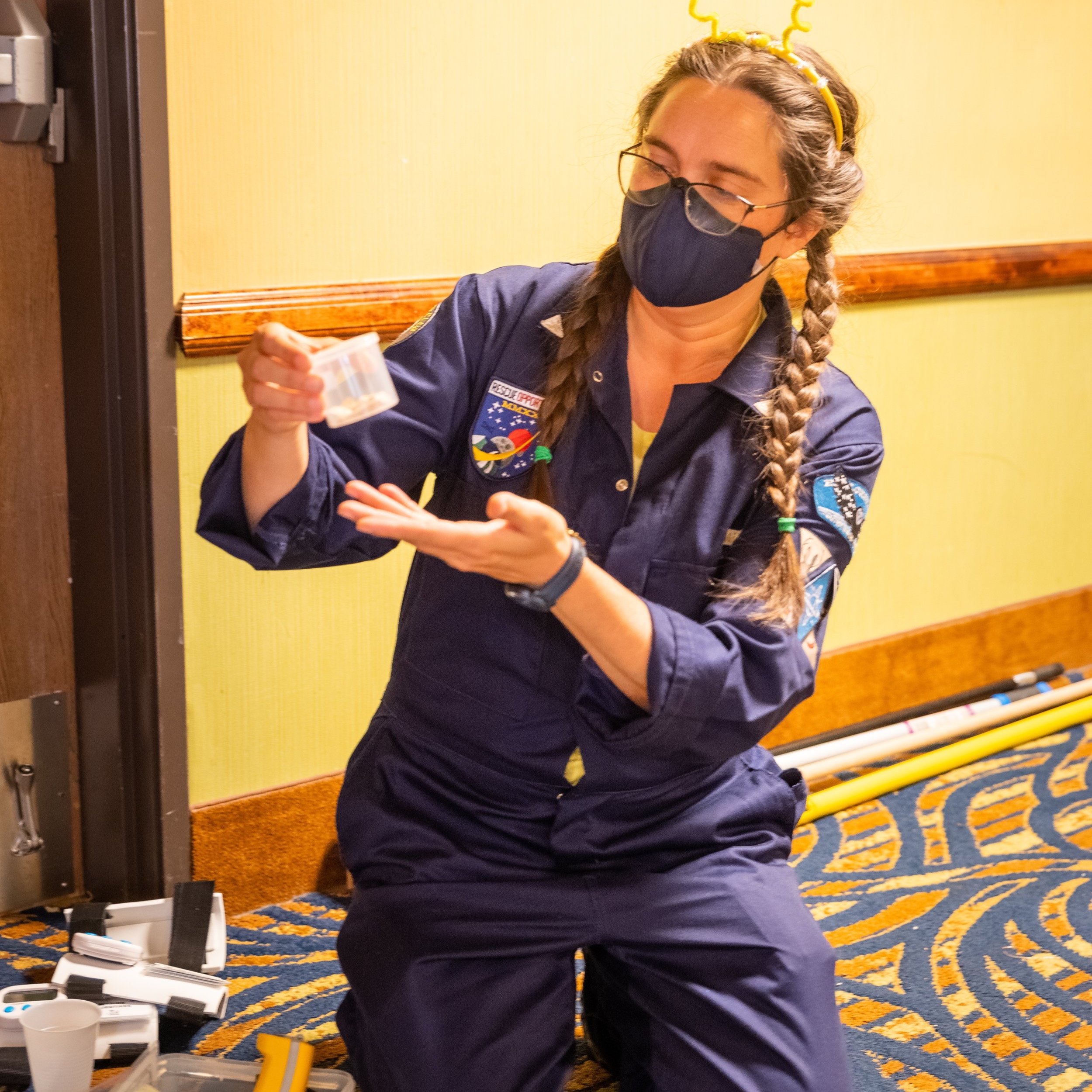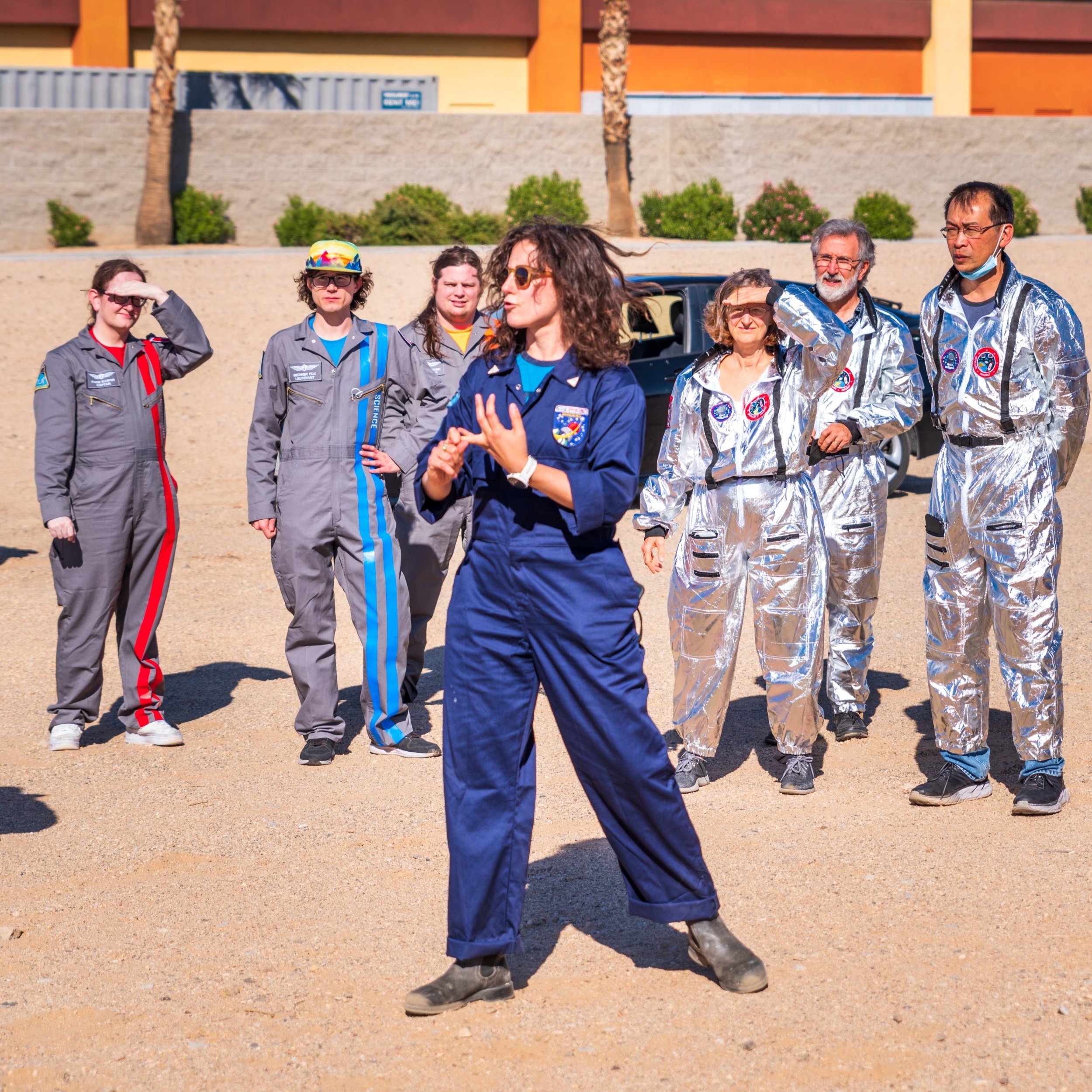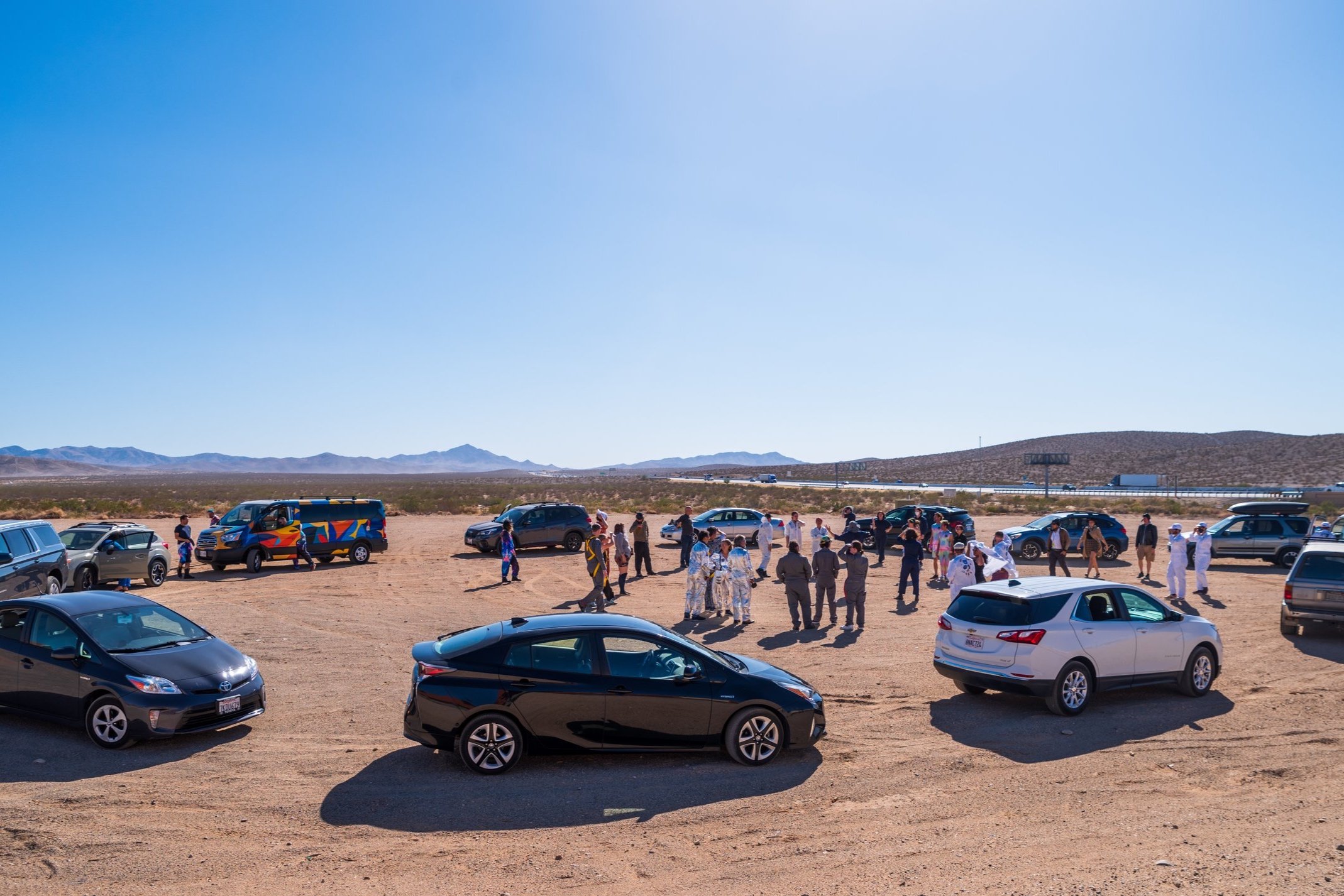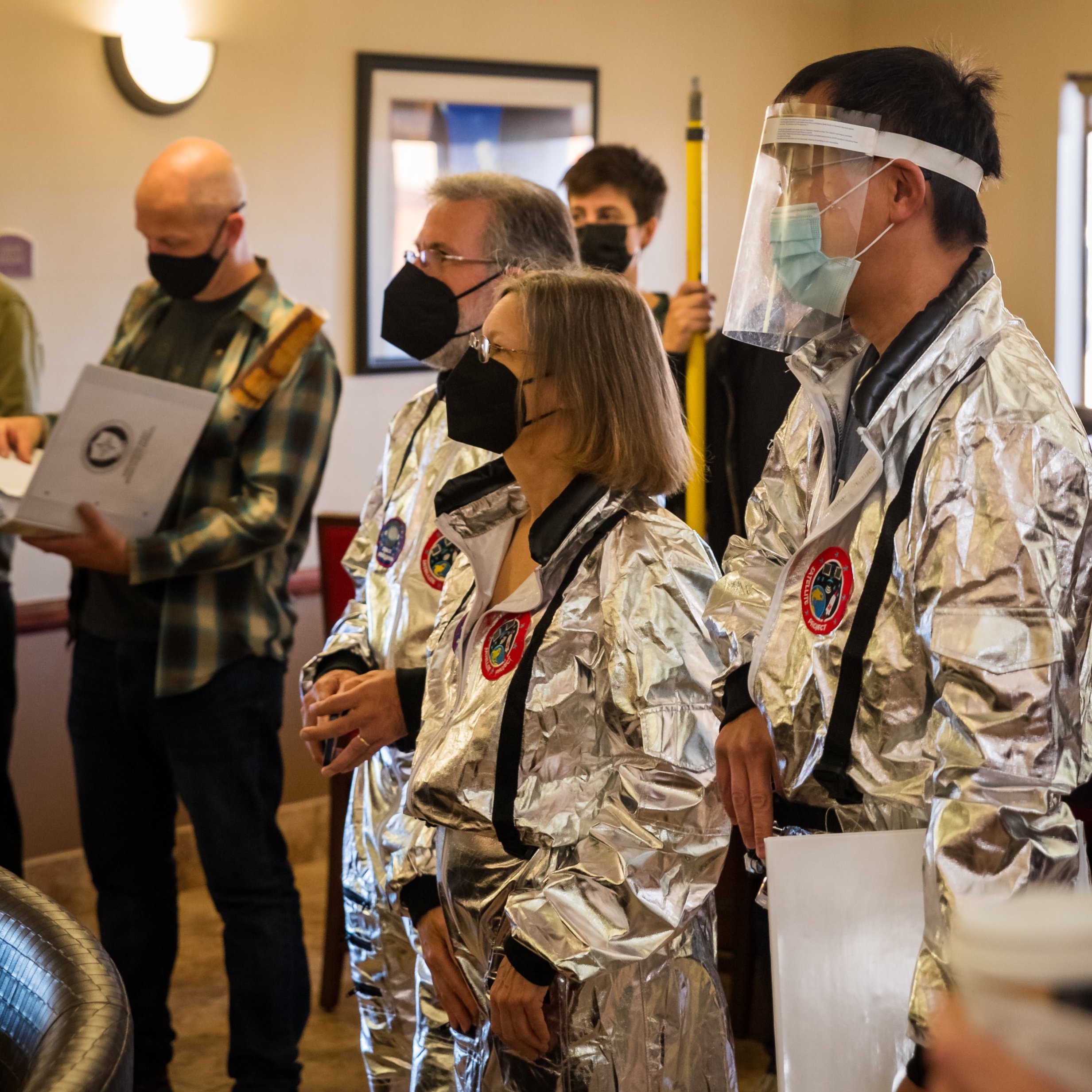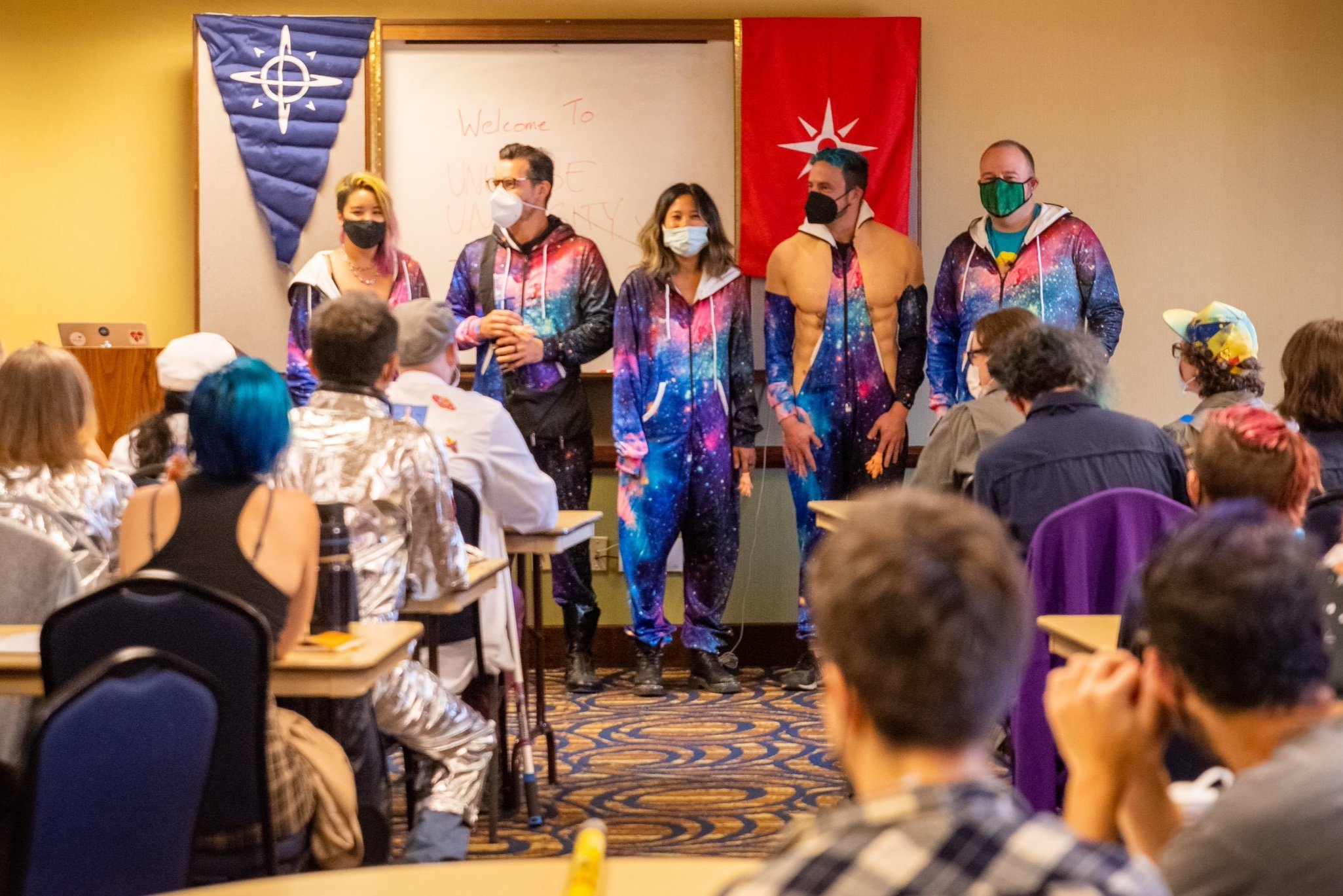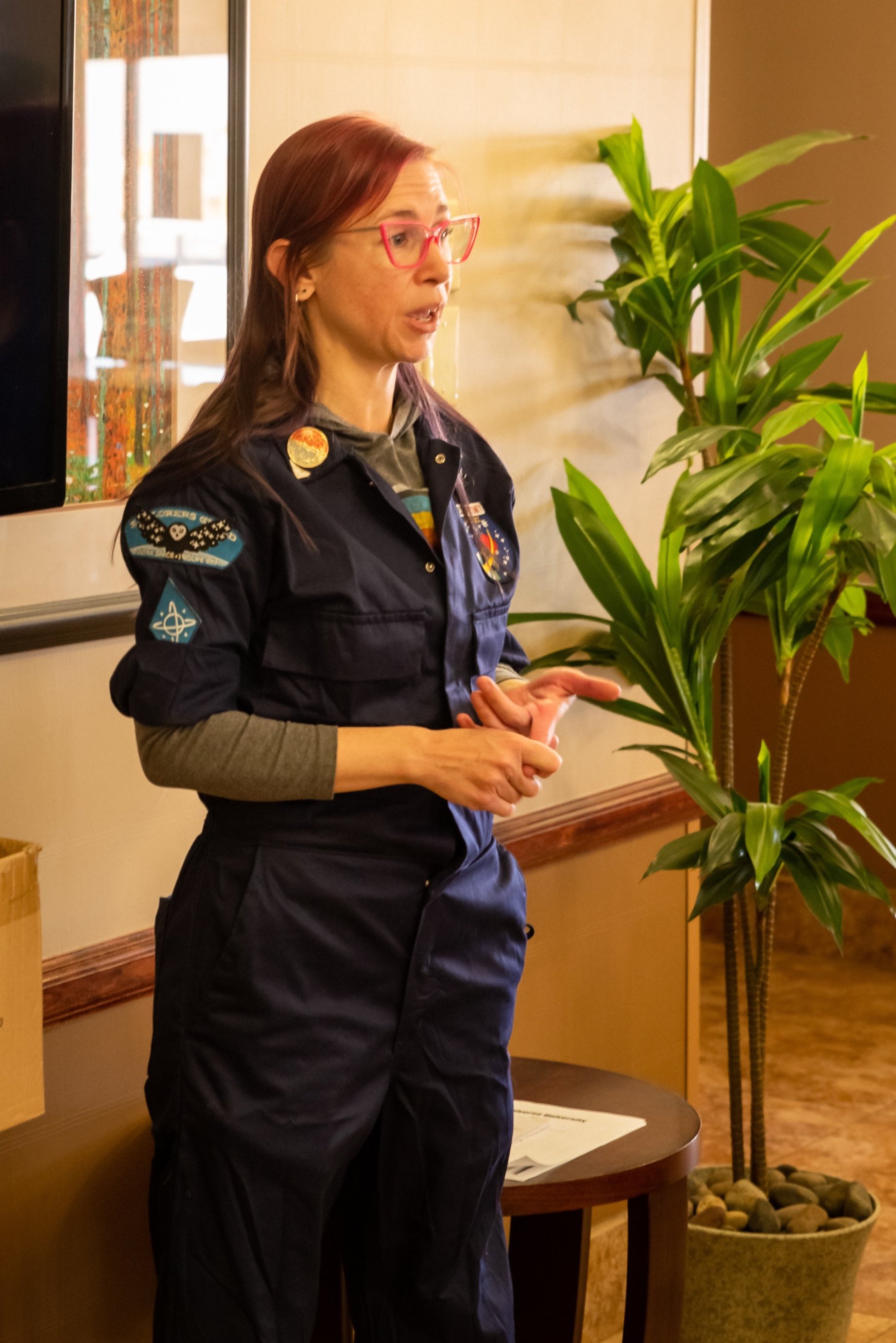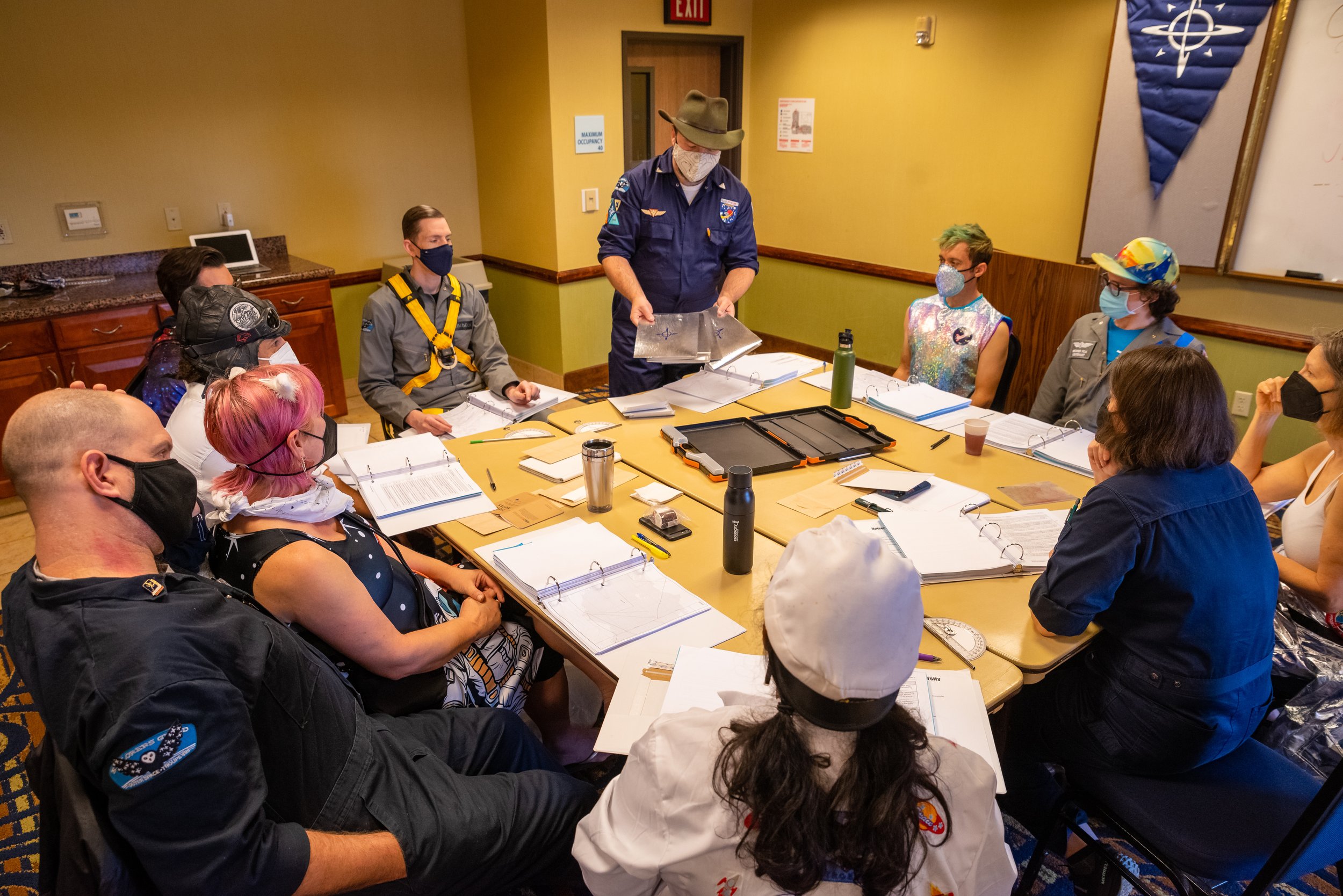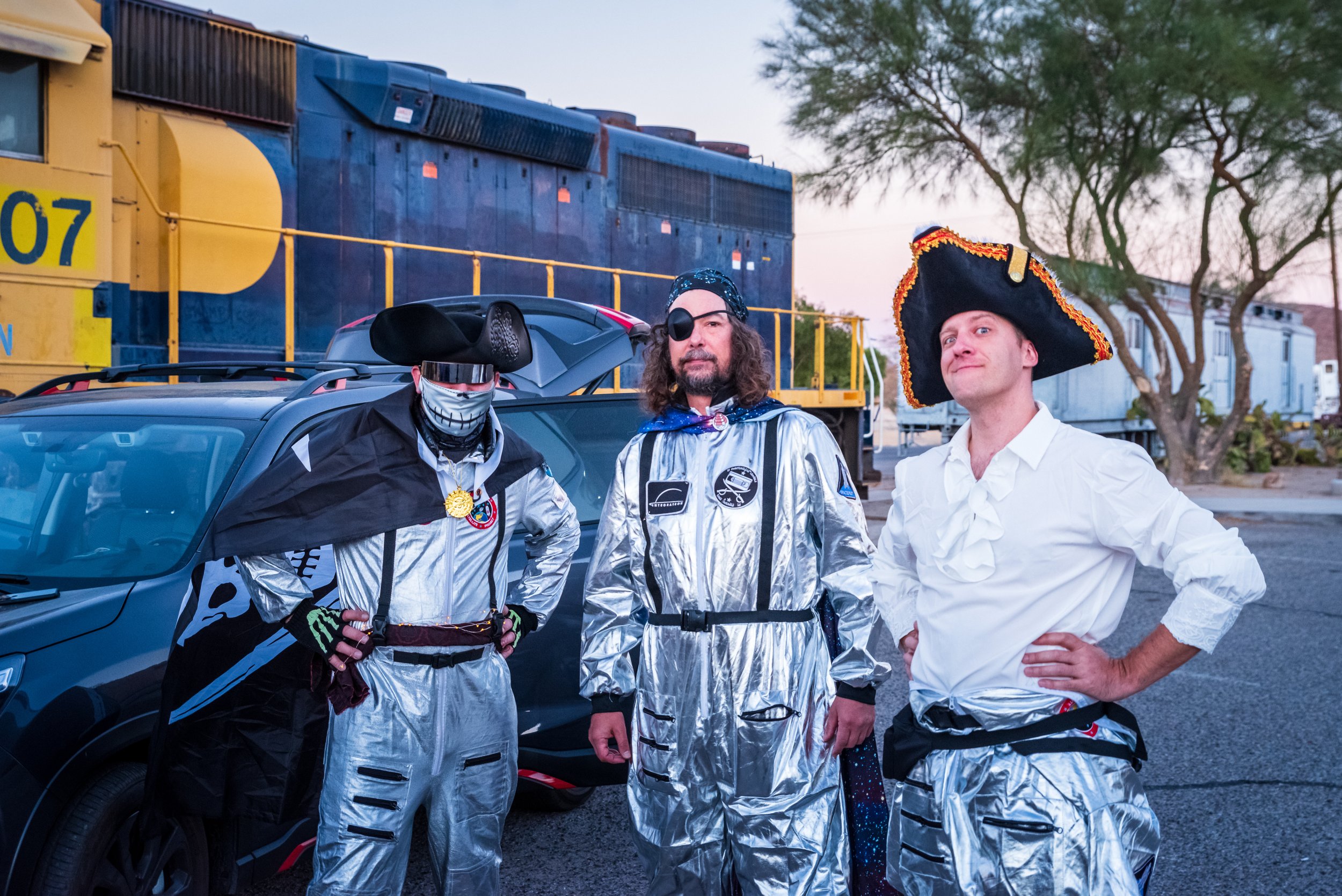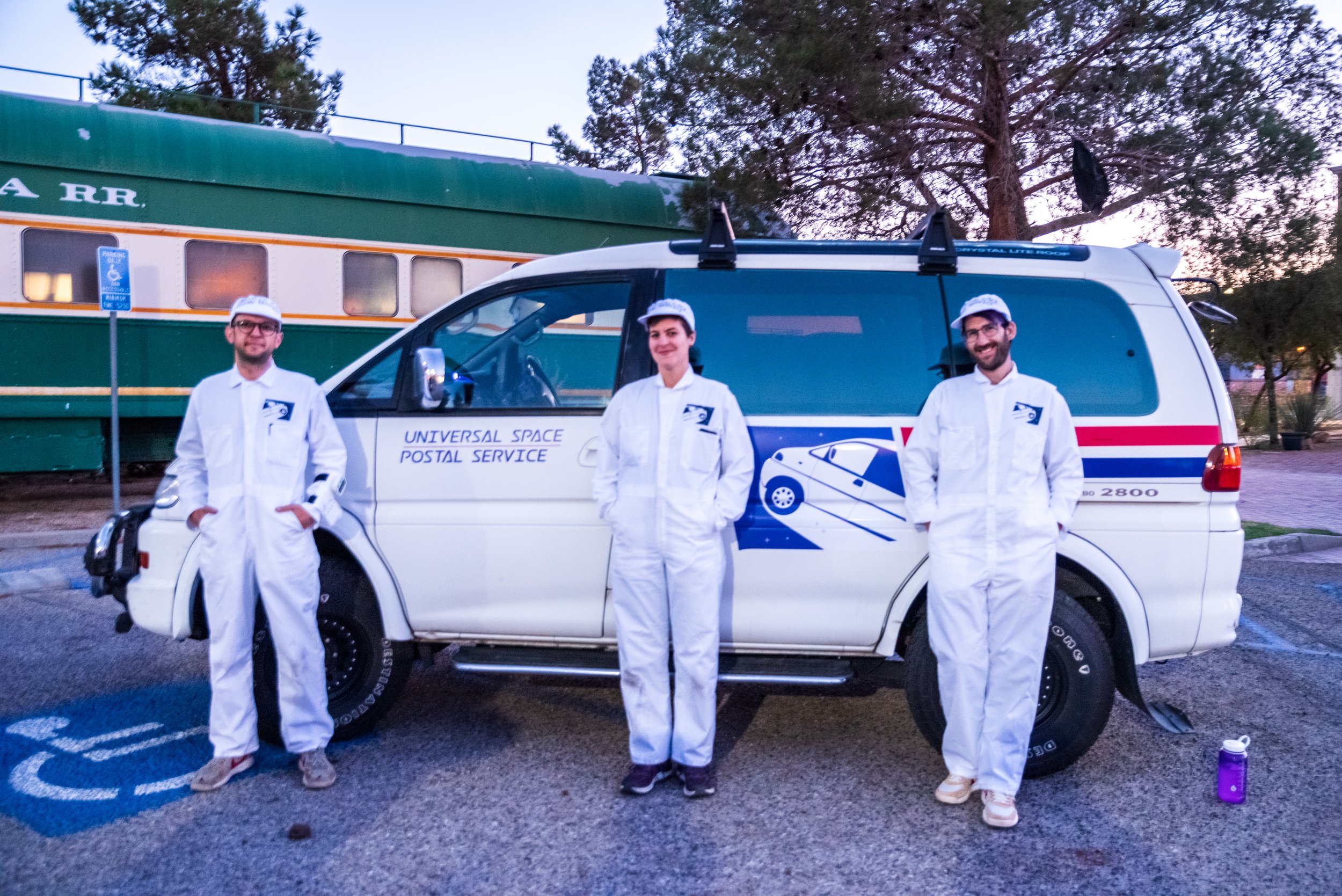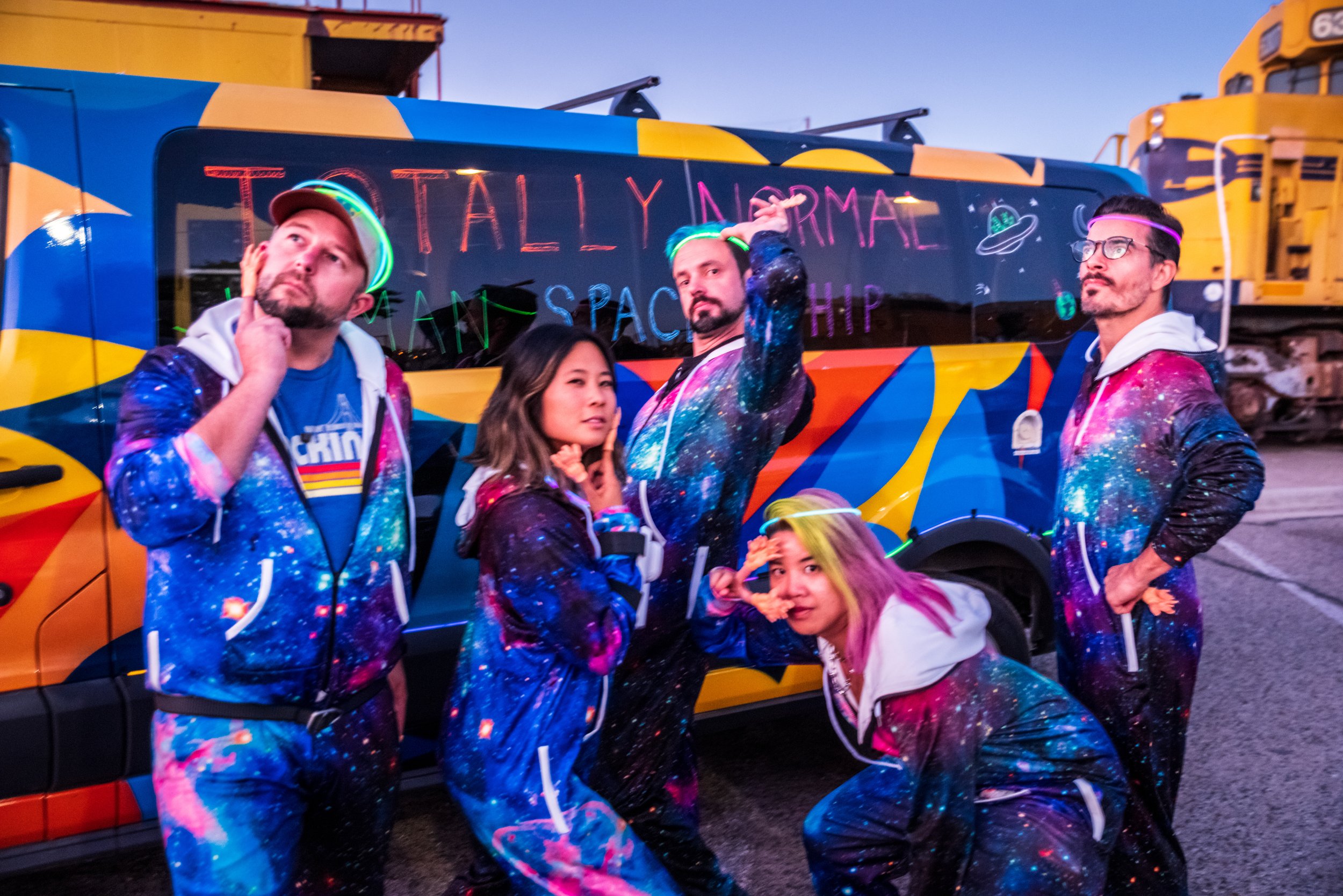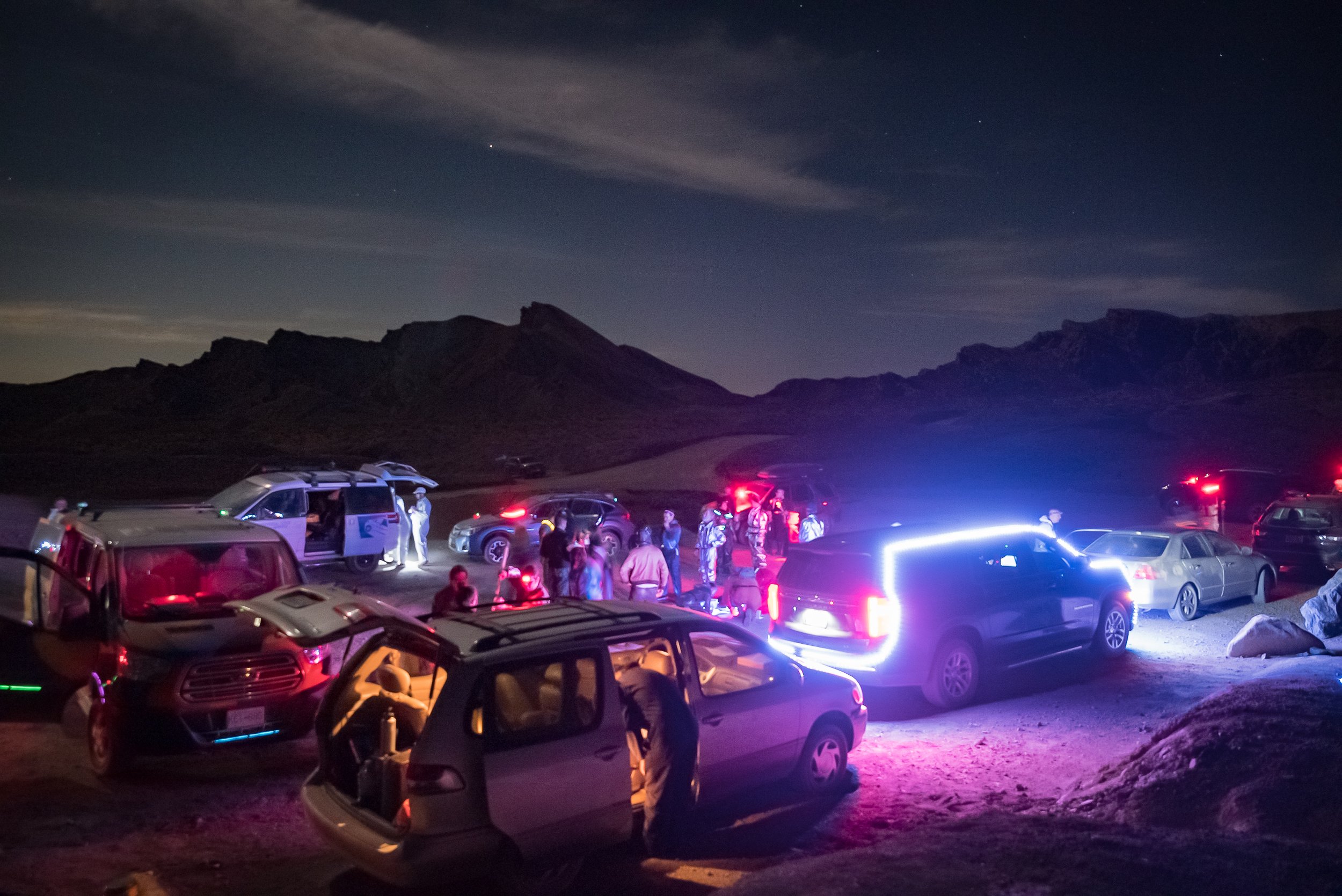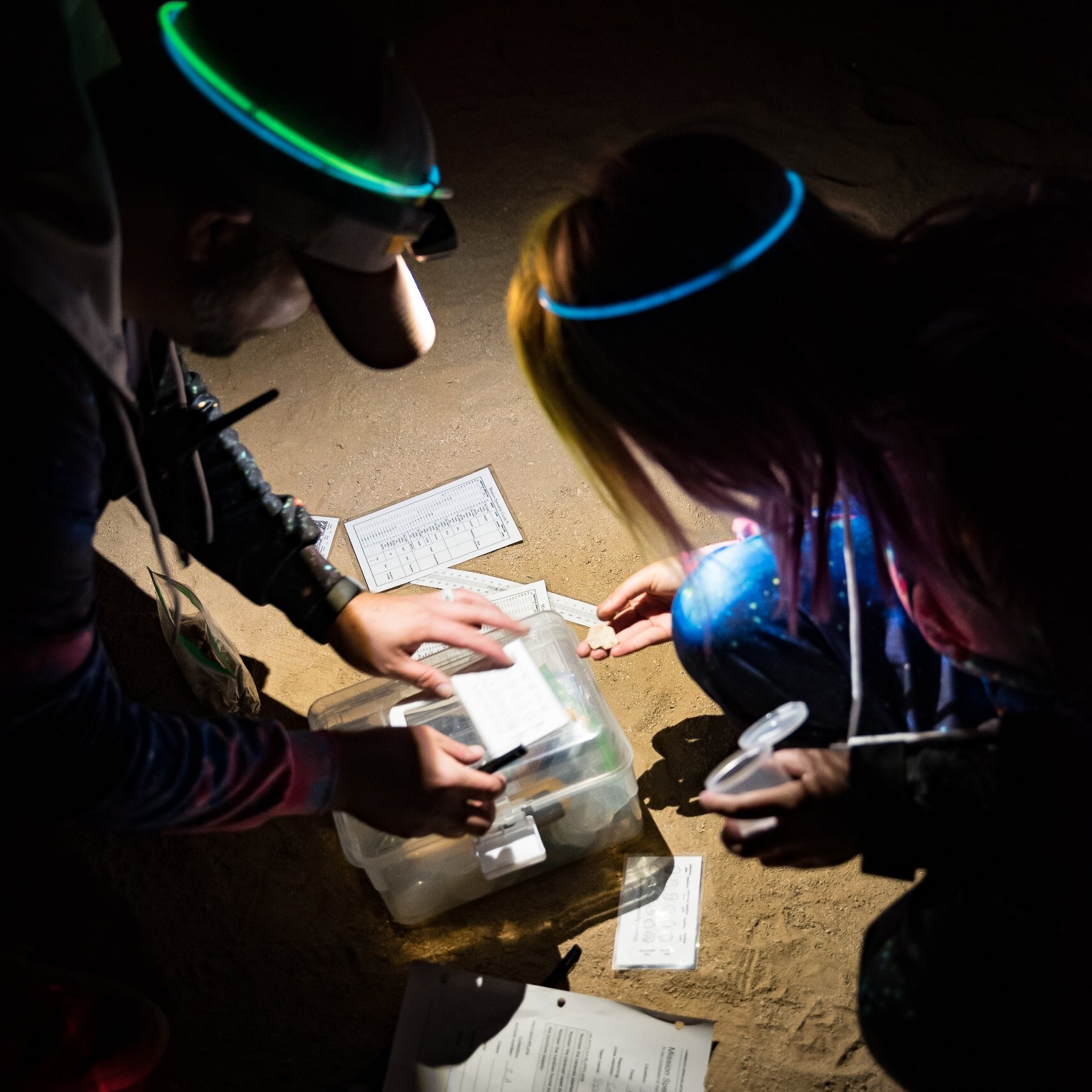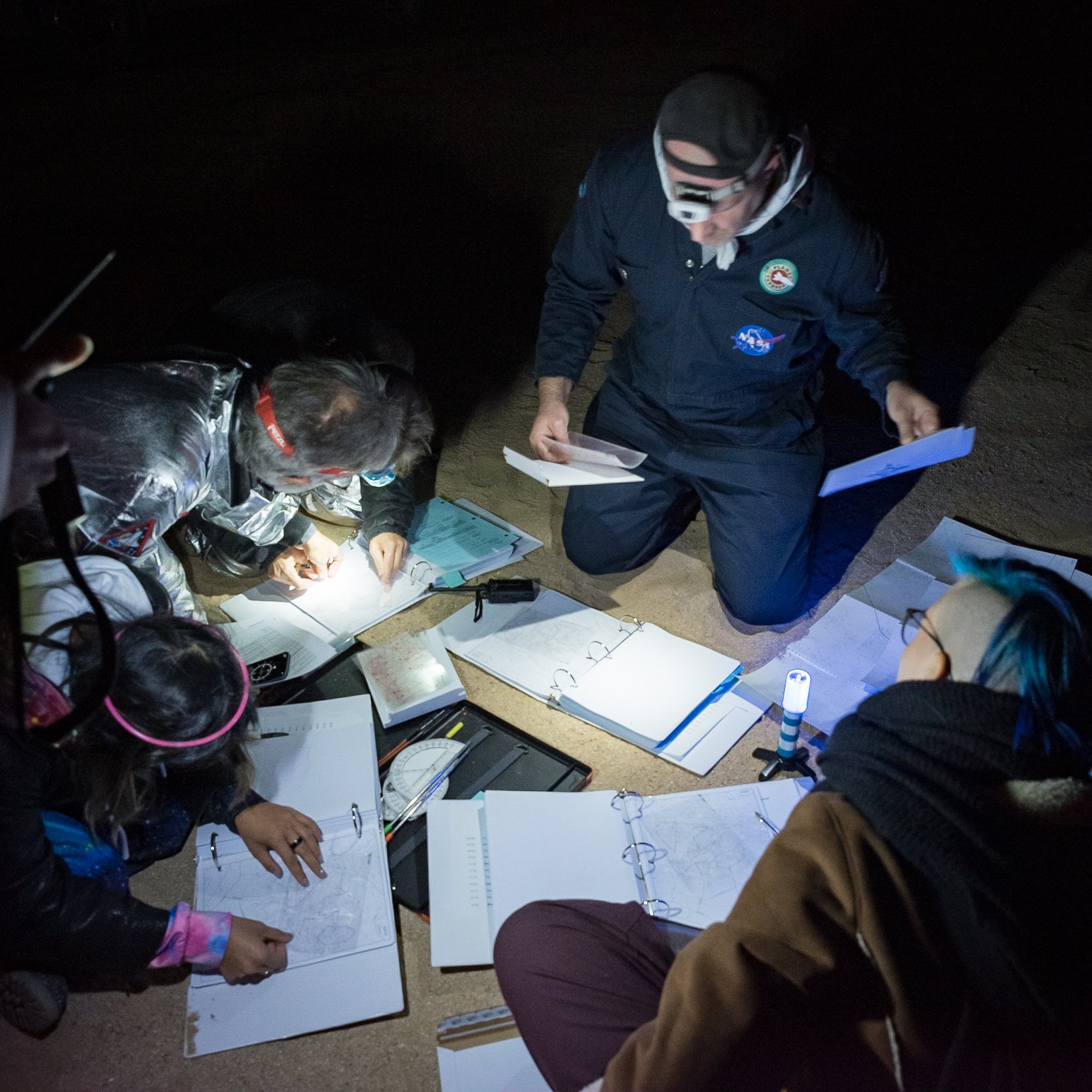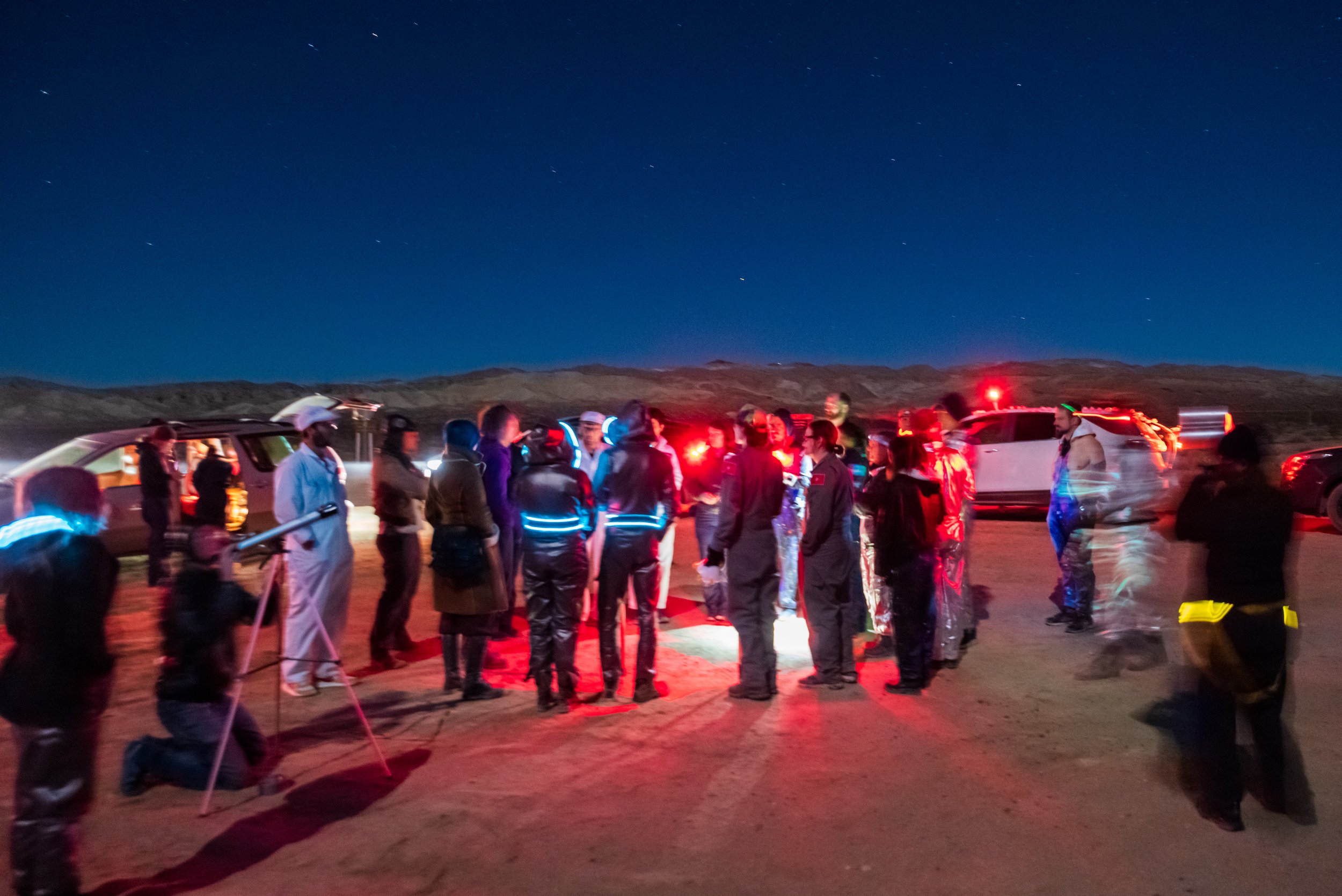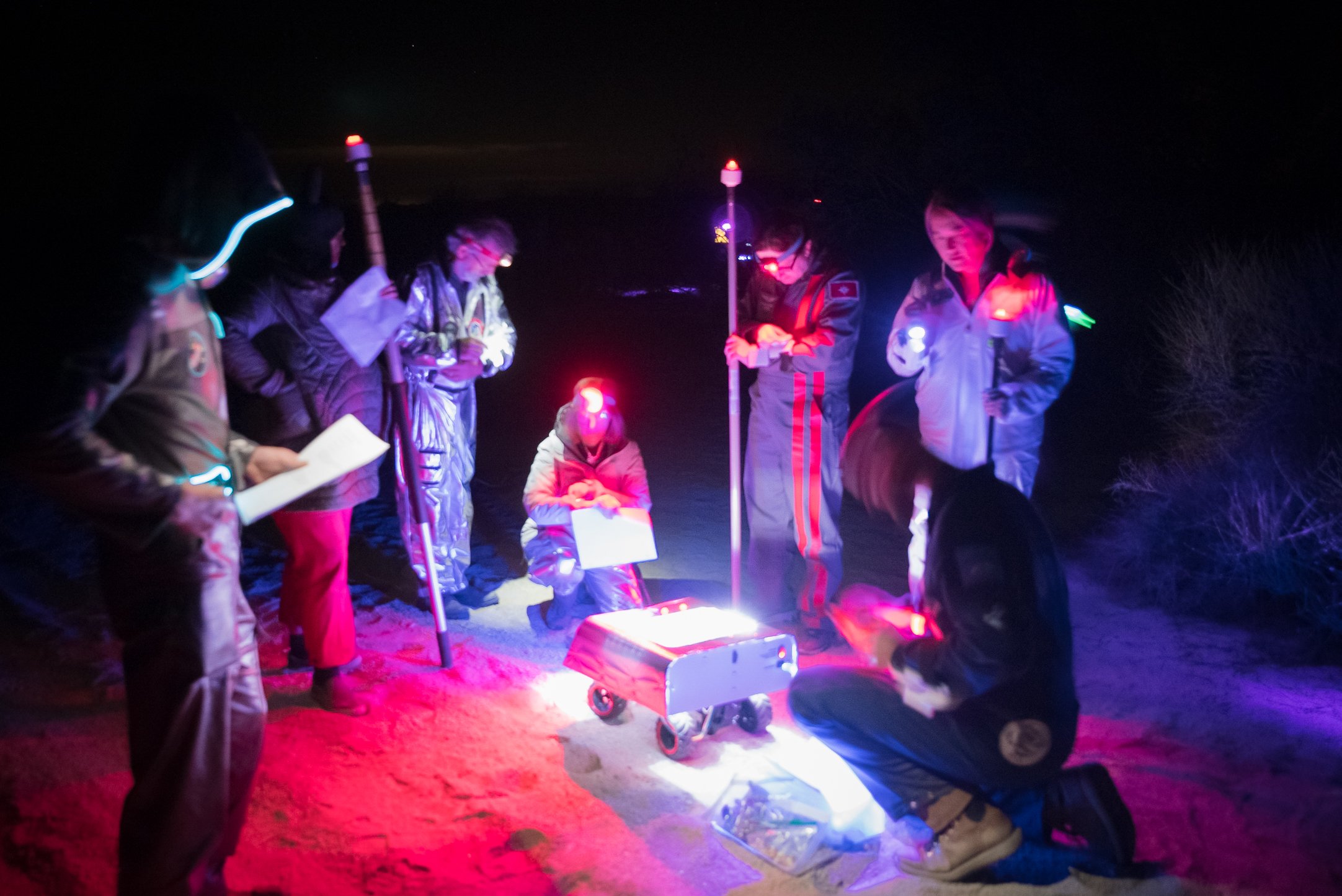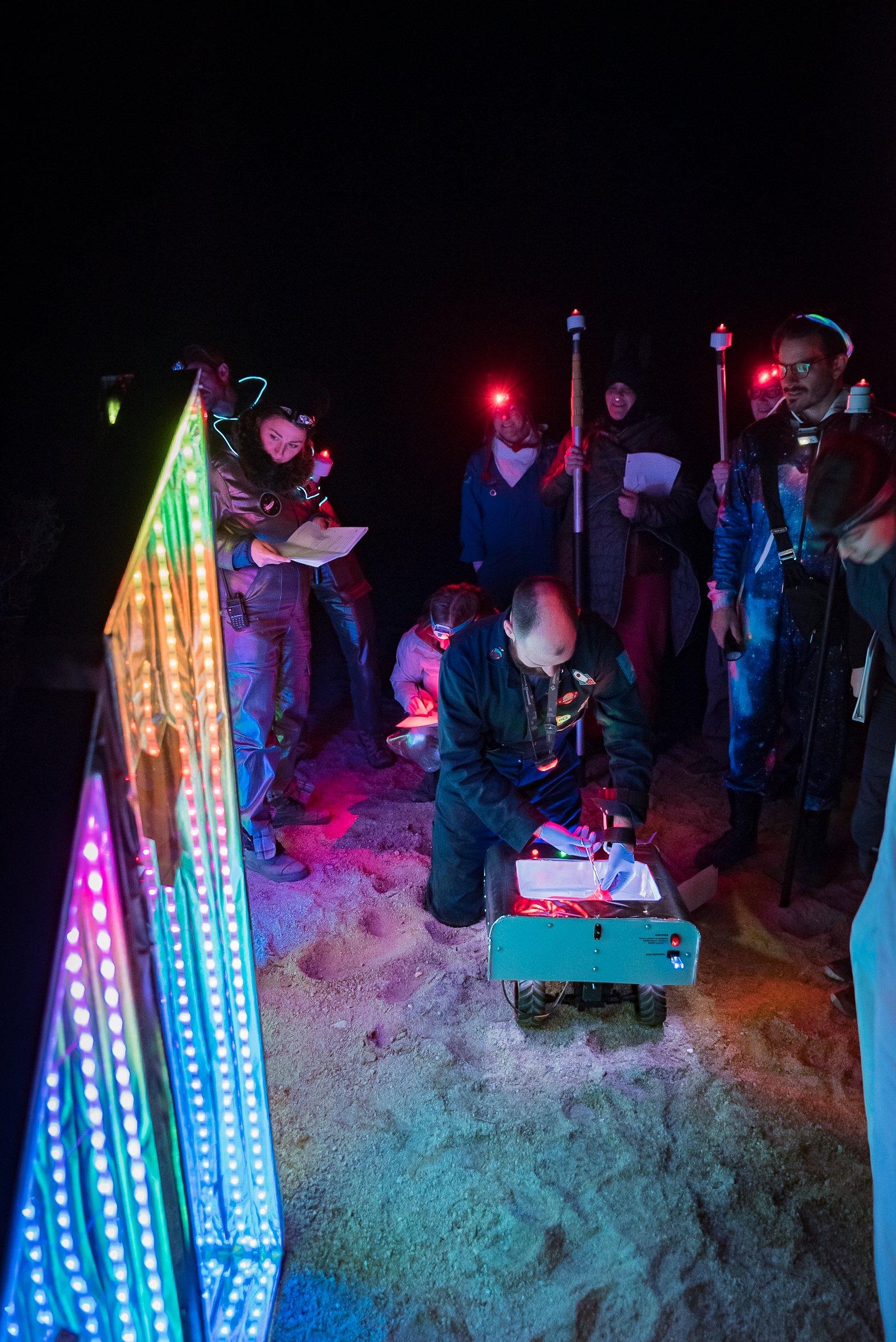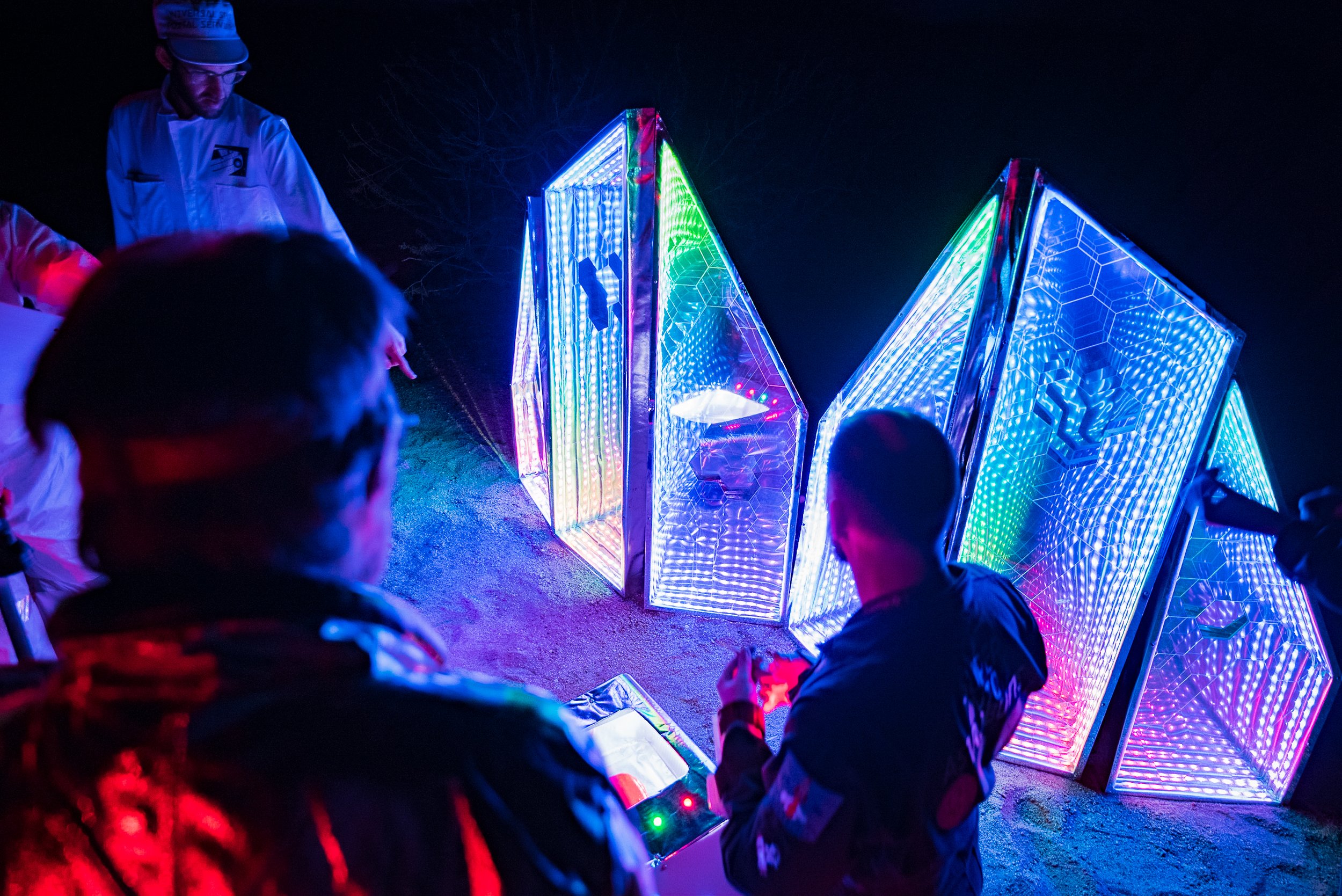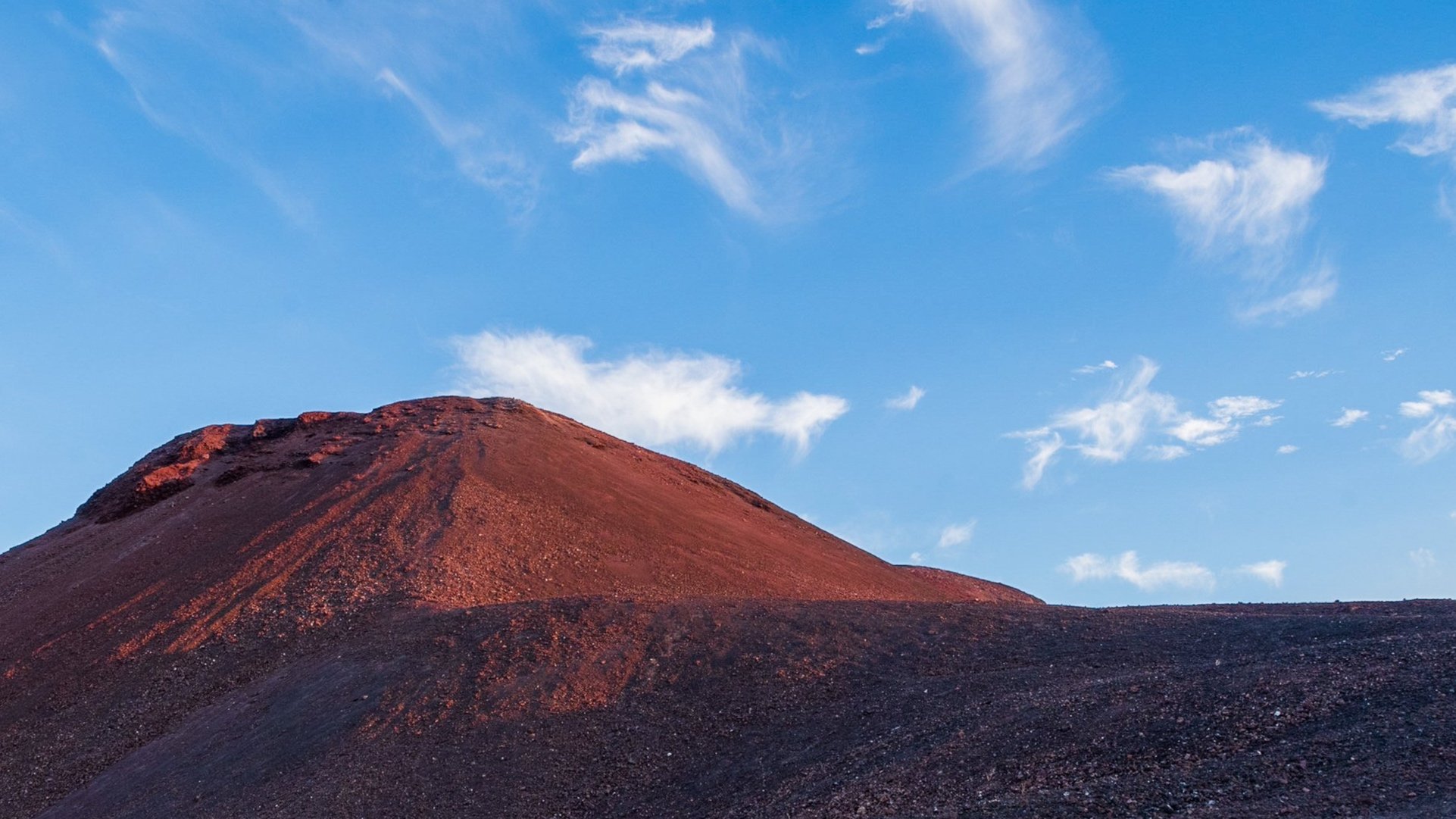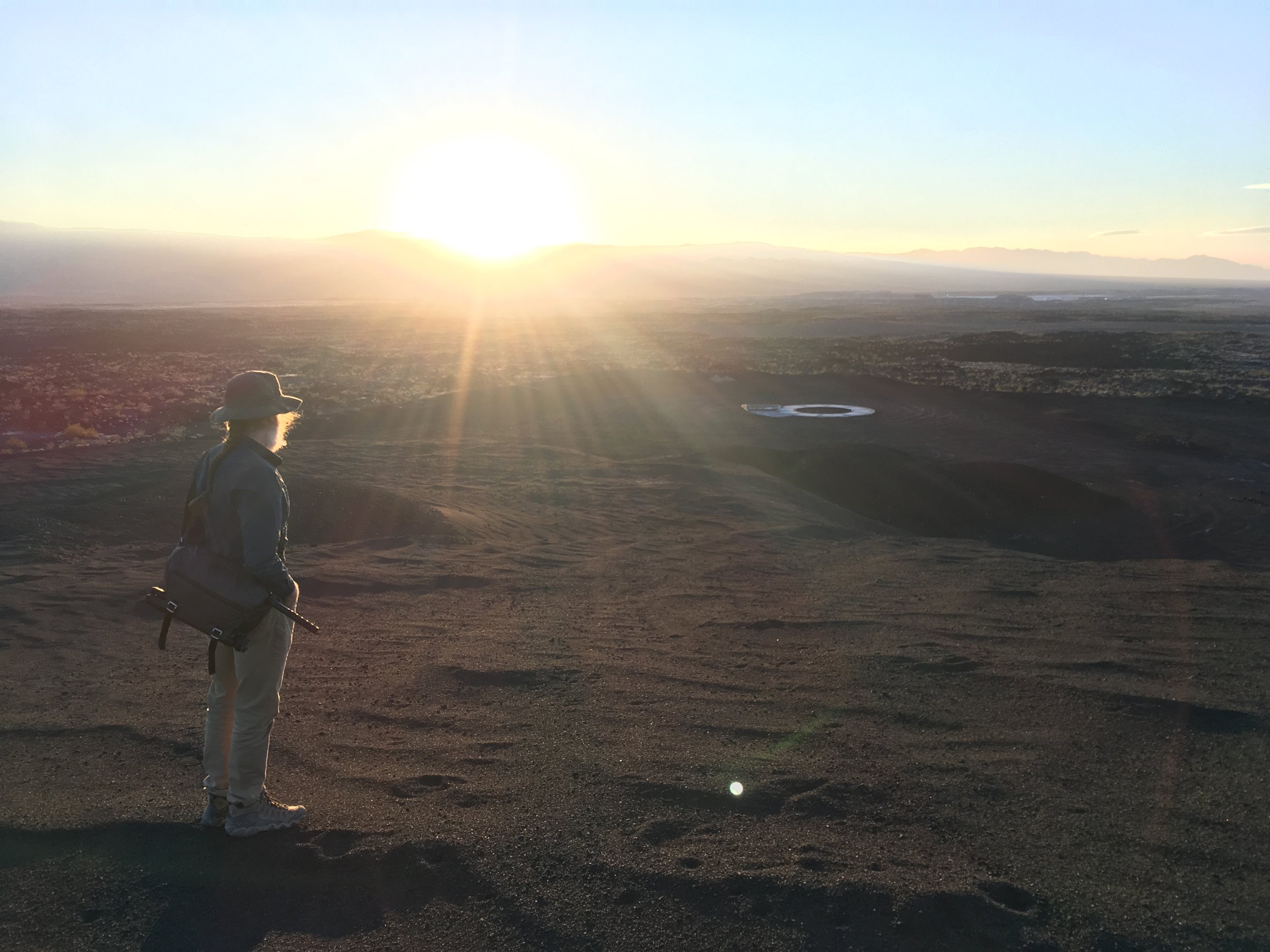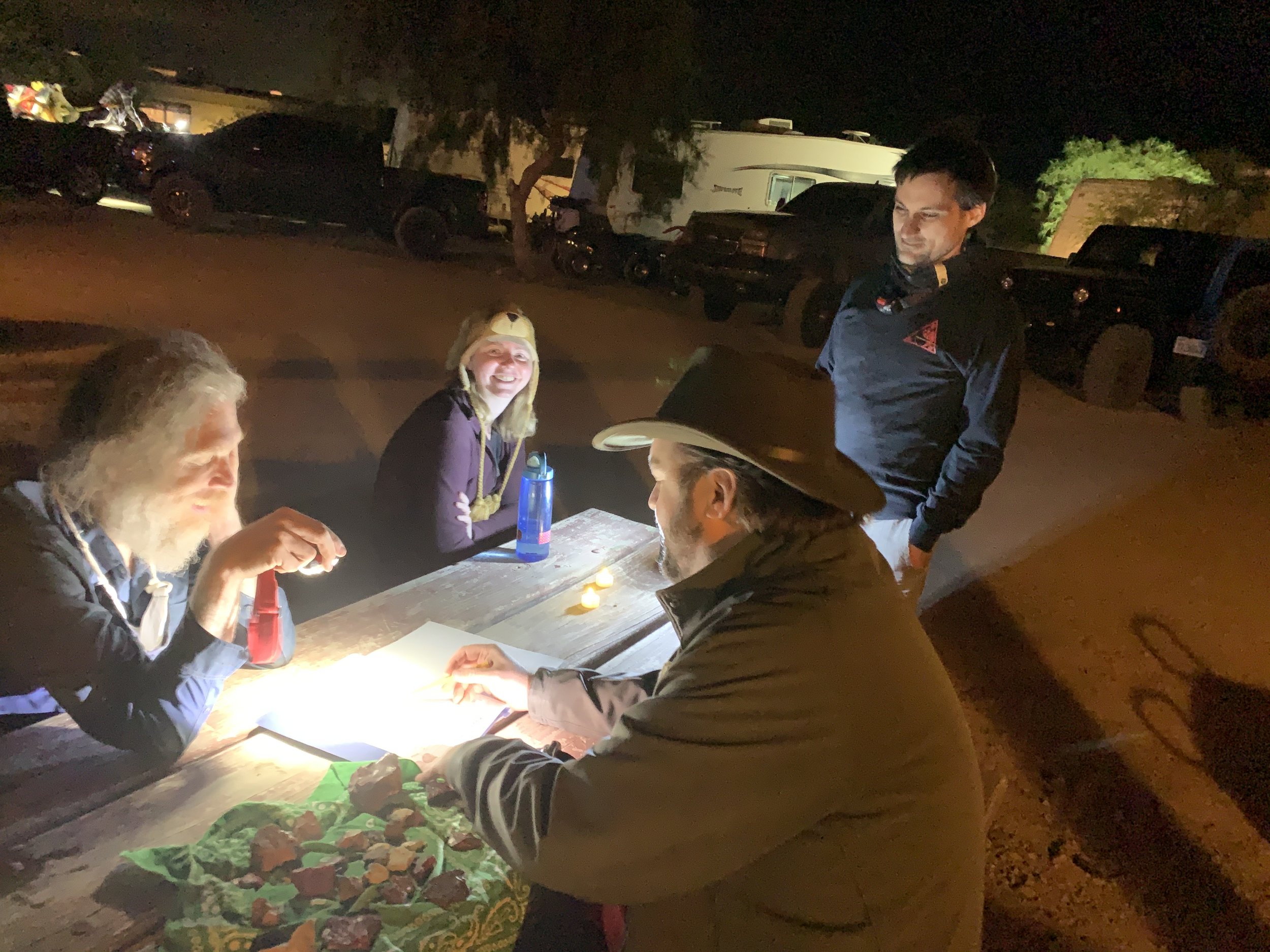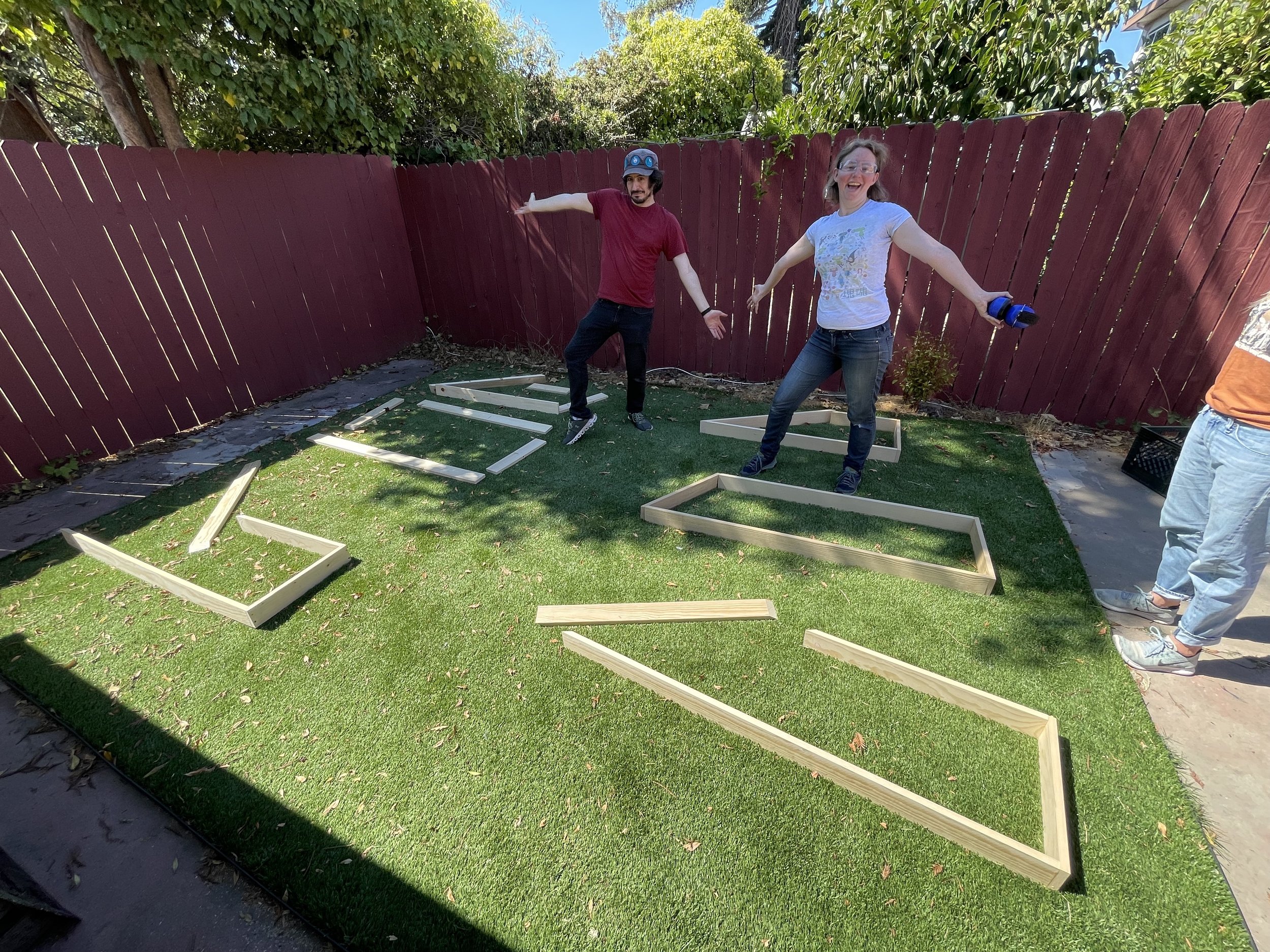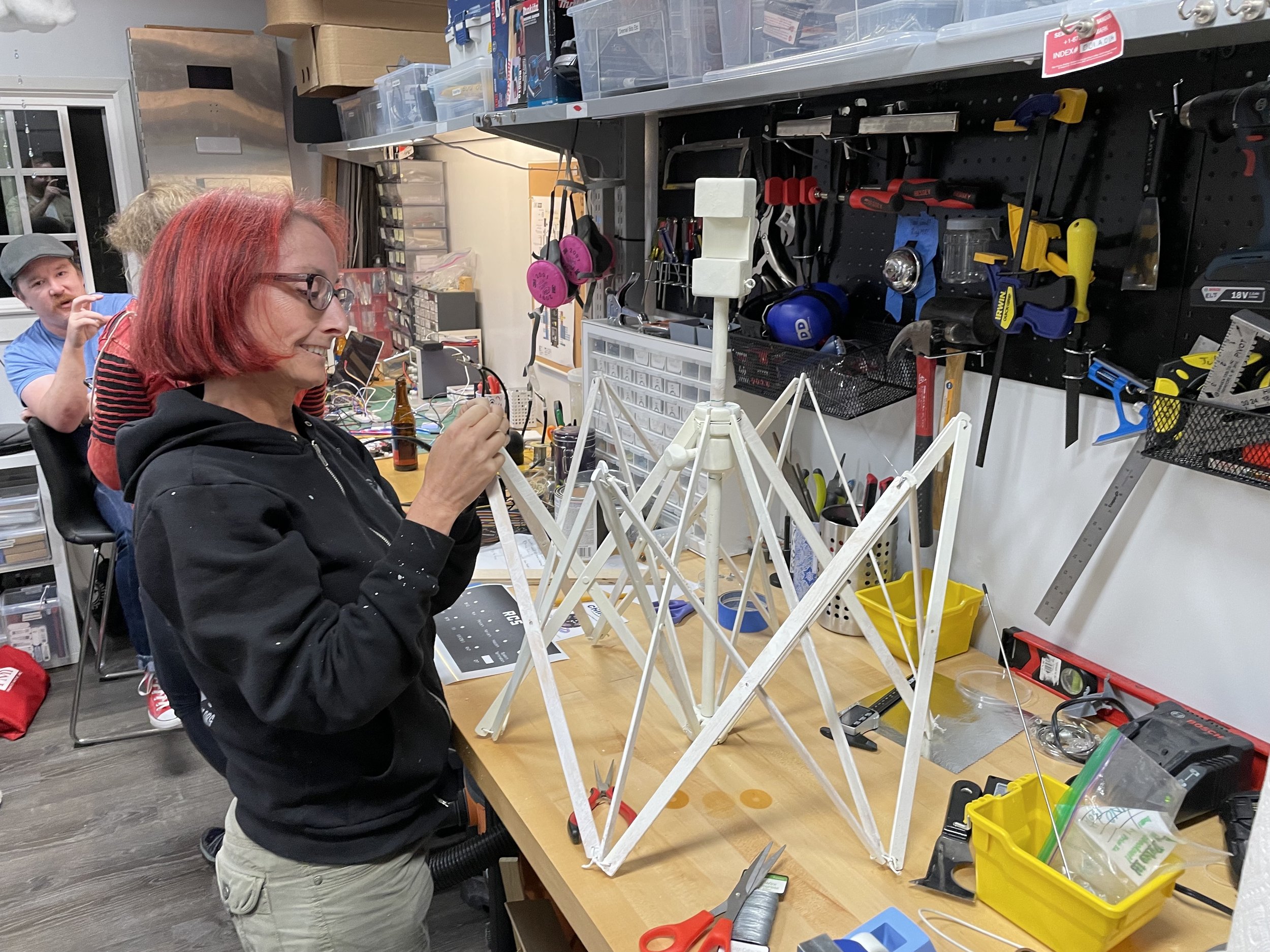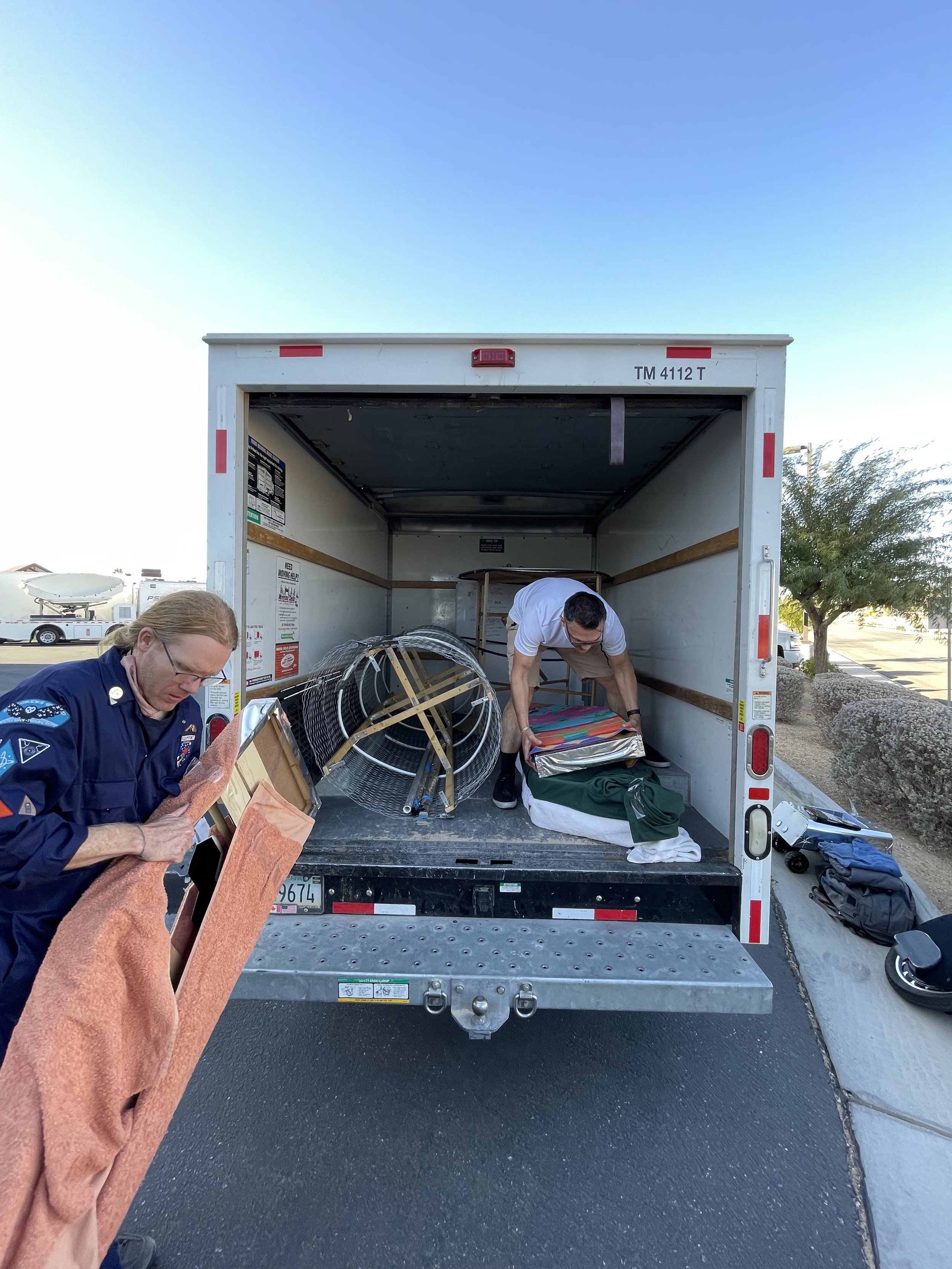Caravan Rally 2021
Opportunity calls!
The San Francisco Bay Area Explorers Guild Troupe 001 is thrilled to announce their greatest call for adventurers yet as they seek explorers with the right heart, mind, and no small amount of courage to embark upon a quest into the deepest, darkest mystery known to humankind: outer space.
In the near future, NASA and the United Nations announce a new joint venture: the Mars Opportunity Challenge. Its objective: find the lost Opportunity rover on Mars and return it to Earth.
Enter: Space Troupe 499, a dedicated team within the Explorer’s Guild whose sole purpose is to develop technology capable of safely carrying humans into space. Years of research has resulted in the ability to convert most earthbound vehicles into spacefaring starships. International and corporate space agencies were skeptical of Troupe 499’s inclusion into the Mars Opportunity Challenge at first, but their establishment of an interstellar rover program and moon-based research station demonstrated their talents and innovative thinking.
With that, we are excited to announce that we have been accepted and will be launching our mission on October 15th to rescue Oppy!
But first things first - we need Explorers (nay, astronauts!) on our crew. The Rescue Opportunity expedition is for you if you:
Are ready for a challenge that will test your endurance as it takes you into worlds unseen
Believe the exploration of space should be open to everyone
Are committed to exploring the edges of discovery to understand life in all its forms
Can work with good humor as part of a team to achieve a common goal
If this is you and you’re ready to jump into the cockpit, now is the time to form a team and register!
If you’d like more information on the mission and to hear the needs from Mission Control, we’ve supplied some further background below.
We also have a breakdown of what this all means and requires if you’re interested but need to cut through our excellent marketing and lore creation department to know what you’re signing up for.
Mission Background
“My battery is low and it’s getting dark.” These were the final words transmitted from the Opportunity Rover on June 10, 2018. This was right before a massive dust storm blanketed the Perseverance Valley where the rover was exploring. More than a thousand commands were sent to restore contact from NASA to the rover, but after months of trying they officially called the rover lost in February, 2019. The Jet Propulsion Laboratory team was reallocated to other projects, and Opportunity’s mission, which was supposed to last 90 days but instead lasted 15 years, was over.
With the dust storm long gone, scientists in January 2020 were reviewing images sent from the Mars Reconnaissance Orbiter and noticed that the Opportunity Rover was no longer in the location where it had failed to reboot. The last picture of that area captured in August of 2019 shows the rover in place, and it was not apparent where it had gone or the path it had taken.
Further investigation revealed that a former Opportunity technician had been occasionally pinging it, “just in case.” Weather since the last photo had been alternately windy and then very clear, perhaps finally blowing enough dust off the rover’s photovoltaic panels to permit its batteries to charge to the point where one of these pings woke it up. However, the rover never replied.
The Opportunity Rover (bright dot in the center of the square) is shown at its last known location in this Mars Reconnaissance Orbiter image.
This unusual occurrence sparked a great deal of speculation and discussion about retrieving the beloved rover in the context of planning future Mars missions. The idea for a contest was initially a joke. The hashtag #RescueOppy began trending after going viral amongst the Discord of an online sci-fi con. Eventually, a few influential individuals and corporations began to take it seriously, suggesting that popular interest in Opportunity could be leveraged for additional support and funding for a crewed mission.
After the bungling of the billionaire space race, UN member states and corporate interests reached agreement that the contract for operation of all travel and shipping between Earth and Mars could be the prize awarded to whatever organization was able to return the Opportunity Rover. Whoever wins this contest will have demonstrated the highest capacity and best technology to make regular travel to Mars a reality.
Contestants
Seeing the possibility of a decades-long government contract, a few corporate entities have mobilized their space divisions. The clear front-runner is Dynasty Intergalactic, which began as a startup disrupting bowling alleys, but their pivot to event production and venue dominance led to the downfall and eventual purchase of Ticketmaster. Their portfolio of acquisitions became so broad and capital holdings so large, that their CEO, Casey Starr, like other company leaders, turned to space as the next frontier of profitability. Dynasty is now poised to become the major player in the space mining and cosmic cruise industries. It’s all but assumed by the public that Dynasty will put its seemingly endless resources into the acquisition of Opportunity, and define the future of space travel.
Realizing we’re the underdogs, the Explorers Guild is asking for willing astronaut teams to join us on our mission to rescue the Opportunity Rover. Our attempt to return it to Earth is in the name of scientific curiosity and continued exploration of the universe, instead of privatised objectives.
The Explorers Guild Space Troupe was formed by members of the San Francisco Bay Area Explorers Guild Troupe 001 who theorized that explorbs, which have long menaced Guild expeditions, might be manipulated to alter gravity and spacetime, produce air and water, and create other effects that could make human space exploration possible. A combination of this Expl-orbital tech and our discovery of a rare space mineral power source for the tech, has paved the way for various extraterrestrial adventures. We gained notoriety by taking a school bus of excited 3rd graders to low orbit, and establishing a humble base on the moon. Our EHNO bot rover program has also given scientists around the world an opportunity to test hypotheses generally overlooked by larger space programs. Currently, the lunar agriculture experiments by the EHNO program are changing views of what’s possible for sustaining life on celestial bodies.
Many in the media have commented that our interstellar rover program and moon-based research station demonstrate the out of the box thinking that gives us a fighting chance to win the Mars Opportunity Challenge. But, they say, whether or not a team’s technology can take them to Mars and back is not the most important factor. Many teams have demonstrated that capacity. Ultimately, superior collaboration, creativity, and commitment will be key to returning Opportunity safely to Earth.
Join The Team
So what does it take to join the expedition? Caravan Rally: Rescue Opportunity is an intense endurance challenge which promises adventure into a world that is typically closed to everyone but the bravest Explorers. This is a once in a lifetime opportunity as the event has limited capacity and the launch window is one weekend only.
We need 10 teams of willing astronauts to help us complete the mission. Teams have a minimum size of 3 astronauts and are made up of explorers who travel together in a vehicle. They should be comfortable being in close quarters with one another over the full duration of the event and should have at least two people who are able to operate the vehicle. Teams are asked to create their own space suits to make them easily identifiable. Your team may be as conventional, or unconventional with their space suits as you see fit. If you are interested in joining but don’t have a team, we suggest asking around the Explorers Guild Slack.
Vehicles must keep one seat open, so a 4 seat Civic can have a team of 3, or a 7 seat Highlander can have a team of 6. It should be noted that interstellar roads aren’t all paved. Though we’re confident a Civic is able to traverse the paths, a vehicle with higher clearance will likely provide more comfort for the occupants. Vehicles should also be confidently driven, so maintenance or a check up ahead of the launch is suggested.
This mission isn’t a race between Explorer teams. Each team will work with the other teams to navigate the objectives and complete the mission together safely.
If there are any questions about these guidelines, prospective teams can reach out for more information.
The Explorers Guild would never send untrained astronauts into the cold embrace of space, so we will be holding an official space training camp called Universe University on the morning of the launch. This event is mandatory for all astronauts. Success on the mission will hinge on this training.
Universe University starts promptly at 9am on Saturday, October 16th, at our facility in Barstow, California. For astronauts who need to travel more than 2 hours to reach Barstow, we strongly suggest staying at the hotel accommodation the evening before. We have set aside a block of rooms for your ease and comfort, but each team will need to make their own bookings. The launch window will be on the night of October 16th, with a planned return time of the morning of October 17th. As the mission will likely be exhausting, we also suggest that astronauts plan to stay through to the 18th.
Lastly, our registration process is thorough to a fault, but Mission Control has identified it as being critical for putting together an untested astronaut caravan. The process happens in the following order:
Team Registration - Teams must first sign up as a group. Have one member fill in as much information as possible. Once that’s done a representative of Mission Control will reach out for the interview.
Team Interview - A video conference call will take place with your team and mission control. Some questions will be sent in advance to be sure everyone is ready. Be aware that most of them have seen a lot of disaster movies about space and may ask out of the box questions to make sure your team is ready for anything.
Individual Registration - With your interview time, an individual registration form will be sent out. This is important to identify personal information like dietary preferences, vaccine status, and emergency contact info. At this time we’ll also be sending a link for ticket payment.
Mission Control has done everything in its power to make this event available to people from a variety of income levels. The fees are a sliding scale: $130 [the break-even cost], $200 [what we are asking people to pay who can afford more], $65 [a lower tier if $130 is unaffordable for you], or if you cannot attend without further financial assistance, please contact us and we will work it out. These prices don’t include lodging and some meals.
All teams must be registered, paid for, and locked in by September 30th. Registration will happen on a rolling basis, so don’t wait until the last moment. Once a full caravan is identified, Mission Control will shut down the registration page.
If you’re still reading this, the event is likely for you. So what are you waiting for? Register a team now.
If you still aren’t convinced and need a further breakdown of the mission, we’ve set aside a page that’s more behind the scenes for you with our Caravan Rally FAQ.
Update: August 30
I’ve had a couple people express interest in knowing what exactly went into applying for the UNOOSA Mars Opportunity Challenge. I really wish there was some sort of secret that I could share with you all, but really it was as simple as submitting the Call for Interest application. Funny enough, they wouldn’t take an emailed version of the application so I had to fax it over to them. The hardest part in this whole process was still finding a working fax machine.
Though our budding space program is still a bit rough around the edges, and it doesn’t have the refined PR department that some of the more corporate entries have, I believe that our technology and enthusiasm more than makes up the difference. I hope to share with you all some of this tech in the coming weeks!
Mars Opportunity Challenge Application, from the desk of Dr. Professor
Update: Sept 2
One of the most frequent questions I get is: "How the hell are you getting my Honda Civic to space?" and "No serious, I don't think my Civic is airtight..." Great questions! We love fielding your most ecstatic concerns about sending untrained civilians to the difficult frontiers of space. I've reached out to our lead scientists in an effort to answer these questions more fully. I got a day or two of that bouncing ellipses, awaiting a response and figuring I was about to get the most epic description. Finally an image came through of some notes on the back of a used envelope, along with a message reading "I'll call you later." It's been a week, so I'll reach out again today, but I'll share what I know with a promise that more will come later.
Basically, ever since Troupe 001 discovered Explorbs there has been heavy research into understanding them. Explorbs are anomalies in the shape of circles, typically found on the ground, and they would trap wayward Explorers in them until they could find a solution to get out. This problem turned into a solution for space travel as (insert scientific description here).
That's how we can use Explorbital Technology to take standard issue earth vehicles to space! Included below is the drawing to help you understand (brief scientific description review here).
As you can see, I wanted to give you more information about how Explorbital Technology works, but I haven't received the call back yet. Next week though, I hope to share more on this exciting field.
Update: Sept 6
As we are preparing to explore the stars, a question came up about the origins of Stellar Cartography. Where did the name originate from?
First of all, for those that aren't aware, Stellar Cartography is the name we give our book of records. On every adventure, jaunt, exploration, or expedition, we take a book with us to document the events. This documentation takes place by pictures, doodles, drawings, short stories, and anything that motivates the cartographer. The role of the cartographer is also fluid. Anyone on the expedition may take on the role, should they find a moment that needs to be archived and the will to put pencil to paper. With a wide array of styles and stories to be recorded, this makes the book an ever changing lens to the events of the Explorers Guild.
Example work of Stellar Cartography. Can you tell the story for this image?
Historically, Explorers have always looked up to the stars and used them to tell stories. The creation of constellations, or the appearance of certain stars throughout the year, make for a beautiful palette in order to illustrate the ideas. It's believed that these stars and stories made up the first accounting of stellar cartography. As the tools for chronicling changed, the older methods of oral tradition morphed into the book form we have today, but the name remained. For those that miss the days of a good story told over a campfire, do not worry as reading a stellar cartography book is just as difficult an art.
Should you find yourself on an expedition, we do hope you take the time to either take on the role of Stellar Cartographer, or take some time to flip through the book yourself.
For those wondering, I was able to pin down our Explorbital Engineers long enough to get them to describe the science behind our methods of space travel. Next dispatch will include their detailed description that should satisfy inquiring minds.
Mysteries of an Explorb, as told by our Explorbital Engineers
Update: September 9
My goodness, it’s been an active week here at headquarters. The Caravan Rally launch schedule is in everyone’s view, with Mission Control making sure everything is perfect. Our Flight Director is crossing all the t’s and dotting the majority of the i’s, the engineers are all busily testing the equipment, and our scientists are making sure all our experiments are thorough. To be honest, it’s an exciting environment to be around. We’d love for you all to join us, and if you’re interested, this is a good week to get cracking.
As of now, we have 13 teams signed up for Caravan Rally. After discussing it with our Flight Director, we’ve agreed that we can expand our previous 10 team limit to 12. These 12 teams will be admitted in the order of which they complete their full registration requirements.
Team registration is step one. If you don’t have a full team, now is the best time to find someone to complete that team. After you complete your team registration, each individual has a personal application to fulfill, and must pay for their ticket. The full team must also complete an interview and book your hotel room(s). Once you’ve done all these steps, you’re in! For those of you looking to start this process, don’t worry, no team has completely finished these steps. But there’s no time to dilly dally as several teams are just a step or two away. If you have any questions about this, you’re always welcome to reach out.
Now, as promised, I was able to get our Explorbital Engineers to explain how Explorbital Technology works. As their time is precious, it seemed best to get a camera rolling and capture what I could for you all. Enjoy!
Captain’s Report:
Rescue Opportunity
The Explorers Guild has returned from its most daring expedition to date: Rescue Opportunity. After writing this report I’m amazed by how overly ambitious and even incredible it seems, but I assure you, the events recorded here are true to what happened. I invite all explorers to heed the following account and take what solace and enjoyment you can until we resume our customary excursions.
THE FOLLOWING REPORT HAS BEEN [REDACTED] FOR CONTENT.
A Call to Adventure!
The Explorers Guild Space Program started late in 2019. Our scientists, troupe leaders, and explorers were considering various options for where to point our compass next. When space was proposed, the gathered members enthusiastically agreed (in spite of concerns our compasses wouldn’t work in space). None of us could have predicted the arrival of the pandemic, and as with many ambitious, passion-based projects during that time, it was incredibly difficult to plan in the face of so much uncertainty about the future. Mind you, quarantine did provide the Guild leadership time to research and test our various hypotheses for how to take Explorers to space. The breakthrough came when we discovered how to harness the power of explorbs (a phenomenon once avoided by explorers at all costs) to provide propulsion and form a life protecting shield. Explorbital technology would be the key to our success.
As our tests expanded to include satellites, a rover program, and even the establishment of a lunar outpost, we received word of the Mars Challenge. NASA and UNOOSA were offering a 99 year contract to shape the future of space exploration between Earth and Mars to the first team to locate the Opportunity Rover on Mars, and return it to Earth. Seeing this contest as the best test for our budding Space Troupe, I didn’t hesitate to sign us up. A week later I received a call from UNOOSA making sure our application was not a joke. It took a lengthy conversation to assure them that we were, indeed, very serious. After making some rather brazen promises about the team we were gathering, I realized that actually recruiting the exceptional group needed to meet those promises was going to be of the utmost importance. I sent a message to Explorers Guild headquarters and a call to adventure was dispatched.
To be honest, I wasn’t confident that we’d have a full caravan of astronaut explorers. After all, who would want to go to space in their own vehicle, using questionable technology, just to serve the motto Semper Explorandum? The enthusiastic response happily laid my worries to rest. [REDACTED] Would they be the most skilled astronaut crew? Of course not - but what they lacked in formal education, they made up for in enthusiasm and a feel for what Semper Explorandum means. Besides, we could teach them! With our roster set, it was time to get them up to speed on the technology that would make their trip possible.
Universe University
Most of the established space exploration community questioned our plan to send untrained civilians to space. I alleviated those concerns by assuring them that we would provide the finest five hours of education at Universe University, our training program based at the Holiday Inn Express at the Barstow Outlet Mall. Our plan was simple: teach our astronauts the basics of the technology and trust that their unique traits and teamwork would be enough to accomplish the mission and return home. We felt confident we could trust them to do the right thing when faced with the challenges of space.
[REDACTED]
As instruction began, we were interrupted by the flight team for Tycho Intergalactic. Tycho is a brash company that has dominated space exploration for the last half dozen years or so. Most of the public favored Tycho for returning Opportunity before any other competitor. When Tycho learned of our launch window, they moved up their launch time to be hours before ours. This led the NASA rep to cancel their time with us at Universe University in order to attend the Tycho launch. I’m uncertain why they felt the need to barge into University University, but they made sure everyone saw them. [REDACTED]
After that, we broke the astronauts into small groups to learn Radio Comms, Star Nav, and the Mission Specialist role. Instructor Jen led our Radio Comms group and found that a number of astronauts already had some training in radio communication. [REDACTED]
I was the instructor for Star Nav, which was a bit more daunting. Realizing that they would be determining their destinations and routes, a few astronauts expressed concern over their ability to properly navigate the caravan. It was a good time to remind them that this was their adventure. Should they make a wrong turn or get lost, they should embrace the uncertainty and work together to get back on the right path. [REDACTED]
Instructor Lark taught the Mission Specialist section. Explorers were eager to learn how to find jauntium, and catalogue rock specimens, but when it came to documenting potential life, there were a few raised eyebrows. [REDACTED]
Led by our Spatial Aviators Hannah and Vanta Black, the caravan took their vehicles out to the lunar terrain testing grounds. [REDACTED]
With that, Universe University was complete. We taught them everything we thought they needed to know, and all that remained was to start their Mission. We would see them next at the Launch site.
Near Earth
The [REDACTED] was chosen as the launch site for its convenient egress to space. One by one, Instructor Lark issued each team [REDACTED]. FLIGHT inspected each vehicle and went through the launch checklist. Other equipment, [REDACTED], the science kit, and the Star Nav files were distributed. The vehicles tuned into the caravan radio station, and jumped on Radio Comms to check in with each other. The sun was setting, and the excitement in the air was electric. Mission Control confirmed they were ready for flight. The last procedure was to check in with the teams to get a “go” or “no-go” for launch. One by one, we received an affirmative “go,” leading to the all clear and final countdown. 10 - 9 - 8 - 7 - 6 - 5 - 4 - 3 - 2 - 1 - LIFTOFF!!!!!
With that the Mission: Rescue Opportunity was a go. Hopefully, Mission Control would see them again, back on Earth with the Opportunity Rover in hand.
Of course, nothing goes exactly as planned, and that was the case immediately after launch. As the cars started to make their way, it became clear that communication was an issue. The cars were known by their team names and car number, but for some their numbers were confusing. Seeing an opportunity to correct this issue immediately, the caravan pulled over. Team Logistics, forgoing their own safety, went down the line counting off each vehicle and assigning new numbers. Reaching the end, they were surprised to find that another vehicle had joined the caravan. With an exchange of confused looks the interlopers asked, “Where are you going?” to which the only answer was, of course, “Space.” Choosing not to assign the unknown vehicle a number, the caravan was able to find new organization and confidence in their formation.
As the vehicles made their way to the near Earth orbit of the satellite relay, a crucial turn was missed in the dark. Car 07, Astrobutts, recognized the mistake but it was too late. If they turned the caravan would split and they had learned that the caravan should stay together. They went along, assuming they’d be able to make up the error. When the caravan reached the expected destination, they were met with [REDACTED]. Where was the satellite relay? Luckily, Navigator Shaon from Team Astrobutt was on the lookout and spotted [REDACTED].
The caravan altered course and approached the [REDACTED], finding their first Mission Objective: the AVA satellite relay. They created their vehicle Explorb and affixed [REDACTED] to the hulls of the vehicles. The caravan split into mission objective crews for the first time. Mission specialists began their search for jauntium; Star Nav began their work on finding the next target destination, and the EVA crew approached the Satellite Relay to unlock the AVA module.
The satellite relay looked inviting enough. There was [REDACTED]. The whole relay hummed with energy. [REDACTED] Not sure what they were supposed to do, one of the crew pressed [REDACTED]. The whole system went red.
Not to be defeated, the [REDACTED] was pressed again, this time [REDACTED]. An astronaut pressed [REDACTED]. [REDACTED] they thought this would be easy, but it wasn’t. [REDACTED] Looking at the clock, there was no way the group could unlock the module before their personal explorbs failed. Quick discussion led to the decision that six members should remain with the rest returning to the vehicles to avoid space sickness.
The six remaining knew they’d need to focus to prevent the whole caravan from running over their life support time. [REDACTED] Each of the six astronauts had to be perfectly in sync with one another. When they reached [REDACTED], the rest of the caravan was watching in anticipation. [REDACTED]. Cheers from the astronauts and Mission Control were heard all around. [REDACTED]
The calm voice of AVA, the Autonomous Vehicle Assistant, introduced itself over radio comms and was greeted by Caravan members. AVA was critical for the mission in 2 ways. As [REDACTED], AVA would be able to guide the caravan in ways similar to Mission Control when the communication delay with Earth became a hindrance. AVA was also the primary interface with any rovers or landers that would be encountered.
With the mission a success, and with the AVA module in hand, the caravan was able to move on to the next destination, the [REDACTED]. Learning from the previously missed turn, it was decided that slower would be faster in the long run. It was also noted that the radio comms range was not consistent between the front and the back of the caravan and people were missing information. Two of the vehicles had a longer range with their radio comms, so they positioned themselves at the head and tail of the caravan and repeated information as they got it. The [REDACTED] was rougher than many expected. Atmospheric disturbances and the presence of craters made communication and careful navigation key. Luckily, finding the [REDACTED] was much easier this time.
The [REDACTED] was a barren outpost on the lunar surface. The [REDACTED] was eerie. AVA reminded the EVA crew that their objective was to [REDACTED]. The crews disembarked, with the mission specialists scouring the rear yard of the station, while the primary EVA crew searched the station itself.
The door to the station opened slowly, and inside it seemed darker than the outside. Headlamps illuminated [REDACTED]. Everything had a coating of lunar dust. As the crew made their way further into the building, rustling was heard and [REDACTED].
[REDACTED]. The reaction from the EVA crew was instant, [REDACTED]. The crew debated what to do to figure out [REDACTED]. They considered reaching out to Mission Control, but opted instead to ask AVA as a test of their new compatriot. AVA suggested [REDACTED].
[REDACTED] The crew could take the [REDACTED] there, but it would take them about 15 minutes to reach the destination, likely beyond their available oxygen supply, [REDACTED]. With the memory of the caravan members who had sacrificed themselves fresh in their minds, the EVA crew didn’t hesitate [REDACTED].
“Come on crew! [REDACTED]” - a rallying cry that could only have happened on the moon, for sure. [REDACTED] Once outside, the reality of the situation dawned on them. [REDACTED] A cryptic response led the EVA crew out into the lunar landscape. Would they even know it when they found it? [REDACTED] Finally a path to [REDACTED] was discovered, but again time was critically short for the crew. Most were instructed to head back to the caravan, while a few ventured forward [REDACTED].
Back at the caravan, the Mission Specialists had found a bounty of jauntium (or other reactive minerals) and were writing their reports. Star Nav had found the [REDACTED], the next destination, and were able to use their [REDACTED] to find an ideal route. There was a problem though. A number of vehicles were experiencing errors with their [REDACTED]. Despite the assurances from the engineers, some of the devices were [REDACTED]. As long as they weren’t in an error mode too long, the vehicles would still be able to safely travel.
The caravan made their way to the [REDACTED]. A sound came through the radio: “Skylark, one-one, this is DuQuense speaking…” The Skylark team made sure to check in with the caravan after each stop. It may sound odd, but it was comforting and something everyone looked forward to throughout our journey. Though the bulk of the approach to [REDACTED] was smooth sailing, piloting in the canyons of [REDACTED] was challenging. [REDACTED] is a particularly rocky destination and getting to the location of the objective required some tight maneuvering. One by one the headlights revealed the truly beautiful, out-of-this-world landscape. Luckily, the piloting lessons at Universe University paid off, and the caravan landed safely.
AVA reminded the crew that the communication delay with Mission Control was about 5 minutes, and could be improved should they find [REDACTED] and program it for the Explorers Guild frequency. An added benefit was that they would be able to continue using their [REDACTED] for charting their course.
By this time, Star Nav was getting in a flow. Despite a couple of wrong turns while piloting, the teams tasked with identifying the next destinations were becoming faster. The Star Nav team would lay out their maps and manuals in the center of the base camp, and then, one by one, check maps that were highly likely to lead to success. The provided [REDACTED] were challenging, but the [REDACTED] would inevitably be cracked. The hardest part was [REDACTED].
The EVA crew at [REDACTED] quickly located the [REDACTED]. The astronauts were not prepared for what they found. As the caravan approached [REDACTED]!
Before them was [REDACTED]. They were simply left behind. [REDACTED] was asking the caravan to terminate [REDACTED]. The mission suddenly had a problem.
[REDACTED]
With that, one member of the EVA crew stepped forward, [REDACTED] and said “There, we did the right thing.”
This became the conversation after reporting to the rest of the caravan. “We’ve got some good news and some bad news. The bad news is that we can’t [REDACTED], but the good news is that we did the right thing.” The rest of the caravan was confused, a bit frustrated, but had to trust that the right thing was indeed done. Their next destination was [REDACTED] and it was time to rest a bit at [REDACTED].
At least that’s what they hoped for, but it wasn’t meant to be.
Voyage to Mars
As the spacecraft were leaving [REDACTED] AVA came on comms to warn of [REDACTED] that had disrupted their system. The caravan would need to [REDACTED] and reboot the system. AVA instructed them to [REDACTED], but it didn’t make sense. [REDACTED]. The caravan was on the Radio Comms trying to identify if they could trust [REDACTED].
Unfortunately it seemed as though they had little choice. [REDACTED]
As the crew returned to their vehicles they were [REDACTED] defacing their spacecraft. It was a trap! [REDACTED] One of the caravan crew reported distinctly hearing [REDACTED]. As the mission crew assessed the damage, [REDACTED] Tycho had stolen [REDACTED]. Unsure if they could trust [REDACTED].
The flight to [REDACTED] was rather smooth sailing. [REDACTED] The park was built as a place to honor [REDACTED], but seeing the massive [REDACTED] was awe inspiring.
The caravan’s [REDACTED] reverie was cut short by members of TOTALLYNORMALHUMANS offering various crew members a [REDACTED]. When it was accepted, [REDACTED] would giddily run off. It was at this moment that, despite their name, the caravan started to think perhaps this team wasn’t [REDACTED].
This conversation amongst the teams was short-lived as [REDACTED] were both struggling with Star Nav. When asked what exactly they were having a problem with, [REDACTED]; they were unable to handle the materials properly. A call to Mission Control went out to note this dramatic change of events. Is there something they missed with [REDACTED] Technology? Is it altering the crew? No other team seemed to be having these kinds of dramatic changes.
[REDACTED]
Hoping that the mission team was experiencing only minor [REDACTED], Vanta encouraged the caravan to move on. All teams lined up, checked in, and when ready his voice was heard over radio comms, “Let’s light this candle and move out.”
It sounds cliché but space is huge. The flight to [REDACTED] took what felt like months. The radio chatter had died down and the caravan radio station went in and out during the journey. The sound of radio silence and static made the journey feel a bit lonely. The caravan did make it to [REDACTED], and faced the most nail biting descent of their entire journey. As the caravan navigated the narrow path to the target location, they somehow missed [REDACTED]. Once they realized this, each vehicle had to slowly, carefully, and tensely reverse navigate the route. Some of the spacecraft decided to [REDACTED]. The miscalculation was time consuming and frustrating, but they finally made it.
On [REDACTED] they were expected to [REDACTED]. The EVA crew were to take their [REDACTED] and make [REDACTED] in the hope of [REDACTED]. At this point the comms delay with Mission Control was 18 minutes, leading them to rely primarily on [REDACTED]. It’s unknown exactly what they were expecting [REDACTED], but it certainly wasn’t this. Undeterred, the crew [REDACTED].
Then chaos erupted. [REDACTED]
With radio comms being the primary way for each of these teams to communicate what was happening, and with each team experiencing problems simultaneously, the comms channels were suddenly jammed with confusion. The Tastynauts crew, a team whose outward space pirate persona led to fun pirate jokes, but whose hearts were made of gold, took charge running between the various crews to make sure people knew what was going on.
[REDACTED] Luckily Dharla Day convinced [REDACTED] that they all needed their appendages to remain intact.
[REDACTED]
[REDACTED] How would anyone believe them? The confusion was tempered by the reality of the distress call coming from their next destination, [REDACTED]. They left [REDACTED], contemplating what was ahead.
Most of the caravan was certain they were heading towards a trap. Despite the insistence of AVA that space treaties required them to respond to the call, they weren’t going to be caught ill prepared. They began to go over scenarios of what to do if it was a trap, even identifying possible teams that would be offered as bait. [REDACTED]
The final approach to [REDACTED] presented a different scene than they were preparing for. It was indeed the Tycho team, but they were in trouble. Their spacecraft was smoking and the team was in distress. The caravan created their explorbital basecamp around the Tycho crash site in an effort to provide some protection while the caravan figured out what was going on. Alpha Skotadi approached to explain what happened.
Supposedly, after they stole the [REDACTED], Tycho planned to reverse engineer it, but were instead tempted to try it out for themselves. Everything seemed to be going fine until the [REDACTED] started to malfunction and they couldn’t get it to stop. The resulting malfunction led them to make a rough emergency landing.
Sympathy for their situation was hard for the caravan. They had stolen the tech, defaced the caravan spacecraft, and even [REDACTED]. Should the caravan even believe them now? Ætla$ and Omega, who were trying to fix their ship, expressed remorse along with Alpha. Only the Tycho commander, Magnus, remained a defiant asshole, though he seemed to be critically hurt.
Alpha asked the caravan for oxygen supplies [REDACTED] so they wouldn’t run out while they fixed their ship, and for first aid for Magnus. [REDACTED] After some back and forth it was decided to stick around while they fixed their ship and let the surgeon look over Magnus. [REDACTED]
With that, the caravan suddenly found themselves one vehicle bigger. The Tycho team would come along to Mars with the caravan.
Mars
As the Caravan began to depart [REDACTED], Mission Control chimed in. Some members of the caravan had received [REDACTED]. This journey was starting to take its toll. Even those that had not received [REDACTED] were missing [REDACTED].
There wasn’t time to dawdle on thoughts of [REDACTED] though. There was a mission to complete and they were close. The route to Mars was set, and the caravan was ready to roll out. The long line of vehicles made their way through unfamiliar landscapes, as the sun’s light began to sculpt the various landmarks.
The approach to the destination began just as the sun crested over the Mars horizon. The caravan of spacecraft ascended a massive crater formation with a dark alien surface. With the basecamp established, the crew formed up. By this time, [REDACTED] had completely turned into a fox, and [REDACTED], a skunk. They still seemed to have their cognitive wits about them, so they were welcomed as a part of the EVA crew. It was time to find the Opportunity Rover.
[REDACTED] When they crested the hill they found the target, Opportunity, and it was unexpectedly [REDACTED].
[REDACTED] How was this possible? As they assembled around the rover, [REDACTED]. The crew were prepared to return the rover, but what would they do now?
[REDACTED]
The rescue mission was changing quickly. [REDACTED] They started to search for solutions: [REDACTED]
Was this it? [REDACTED] The Tastynauts stepped forward, and said in their best pirate accent, “We came to Mars in search of booty, only to find that Mars was the booty.” They presented a pirate hat to Opportunity.
Slowly, acceptance washed over the crew. [REDACTED] They offered to send a message [REDACTED] to NASA and the people of Earth via the Universal Space Postal Service. Then Dorthy Kingdom Crane suggested everyone sing a song for Oppy. But what does one sing to a rover? Naturally the whole crew began singing “Daisy.” With the final verse sung, the team took a last photo with Oppy, then headed home. [REDACTED]
Home
The caravan assembled, ready to leave Mars. The harsh sun beckoning them to return home to a more favorable climate, they started their engines and departed.
Radio comms had gotten quiet. What else was there to say? They had made it to Mars, they found the primary objective, and they chose to go against the mission. On that journey they had to come together as a caravan to accomplish tasks that no one back home would likely believe. Do they even believe the things that they have seen with their own eyes? What did it matter anyhow? They were coming back empty handed.
Mission Control had identified one last destination for the caravan. [REDACTED], they looked into space to see the small orb of home in the distance. At that moment, they heard [REDACTED] beckoning them back to the pale blue dot. Standing there, hearing [REDACTED], they knew it was time.
The crew got back home to Universe University unscathed but exhausted. Mission Control had arranged for a meal to be ready for everyone and FLIGHT was looking around to see the Opportunity Rover first. As we all ate, the NASA representative, who was supposed to be at our launch, showed up. As the first team to return, they were looking forward to the debrief and starting the new partnership with the Explorers Guild to keep exploring the stars.
The room settled and the debrief began. Blow by blow, as this report reflects, the events that took place were recounted, with follow up questions asked as necessary. [REDACTED] had returned to human form and TOTALLYNORMALHUMANS were behaving like, well, totally normal humans. When they got to the description of Mars, the NASA rep was clearly confused how [REDACTED]. I realized [REDACTED] with stories like this we will undoubtedly continue to explore the vast reaches of space.
Semper Explorandum
[REDACTED] This was something that no one else has ever experienced, and the choices they all made were theirs.
This captain’s report was created in an effort to document this story as best as possible. Although everything that is written is true, the individual experiences had by each astronaut may differ slightly from this official document. After all, how do you document the experiences of 40 astronauts? It’s impossible. Each one had unique experiences that will stay with them in one form or another.
A week after we had returned home and were struggling to tell our friends, loved ones, and co workers what exactly happened while we were gone, this message came in from one of the caravan’s cosmonauts:
COMMUNIQUE FROM COMRADE COTTONTAIL
Comms officer & hydration commissar, Vehicle 05 (Marfusha’s Litter)
I write this to ground control, and the broader UNOOSA/diplomatic infrastructure following a debriefing that may have been difficult for them to find credible.
To those of you questioning our mental fitness, let me simply say that my state-of-being during the flight was superb. During the active portion, when the spaceship was injected into orbit, the effects of gravitation, vibration and noise, as well as other factors of the cosmic flight, did not have any bearing on my condition. Our technique is very reliable and I, as well as my comrades, scientists, engineers and technicians did not doubt for a minute its successful completion.
It may be difficult to accept, but we found Oppy, [REDACTED]. When we asked for a mission report, we received a burst transmission, which we interpreted as [REDACTED]:
[REDACTED]
And it all became clear to us: [REDACTED]
Certainly we are familiar with tales of brushes with death that force a living being to reconsider their core priorities. Can we not extend this to [REDACTED]?
And if [REDACTED]? We asked that you recognize the Opportunity challenge as completed, [REDACTED]
For those of us calling our result a disappointment, I ask the following: What does it mean to explore?
A mission is assembled, to explore the unknown, collect what knowledge can be had, and report back. But what happens when the unknown is not encountered as expected?
Exploration is one thing when it means going out to the edge of the map and reducing it to a series of resources to collect and exploit along predetermined lines. It is a simple matter to follow protocol, and reduce a potential encounter with the truly unknown into a set of checkboxes.
It is another thing entirely to let that encounter change you, to let it challenge your sense of what could be.
For many hundreds of years now, exploration has often accompanied empire of one form or another. (Including, admittedly, the soviet one that produced my warren of space-rabbits.) They would plant their flags, and take their trinkets, and fail to learn from the [REDACTED] they met.
So, what does it mean to explore, and what kind of exploration are we doing?
We are on the cusp of a new era. Let us not repeat the mistakes of the old.
Solidarity forever,
Comrade Cottontail.
With that, I look forward to exploring the stars with you all again.
Semper Explorandum Stellas.
Dr. Professor
THANK YOU
Many hands were required to make this production happen. At one point or another, each of these people took time to ensure the astronauts would find success in the stars. A special thanks is extended to all of these people for their help and generosity.
Production
Alison Callahan
Ann Juhlin
Avalo
Be han
Byzantium
Celcius
Dan Kurtz
Denorae
Deprong Mori
Dr. Professor
Dutch
Ed Fine
Elevan
eXmarksthe
Griffith
Hannah Jackson
Jen Herchenroeder
Jessica Lachenal
Jonathan Mayer
Katori
Kinnabari
Kirk Tarou
Kyla
Lark
Lisa Skinner
Maya
Mokey
Mu
Panopticon
Raining Chainsaws
Rion Snow
Rob Norback
Scott
Scylla
Slater
Tim Jones
Toby
Turtle
Tybeck
Vanta Black
Vynce
Wisp
Yes
Yosh!
Zepheer
Additional thanks to: Rebeca Walker Marquez and Michael Terry
Photos of the event are all courtesy of Tyler Heibeck
Event Run Crew
Denorae
Dr. Professor
Hannah
J L Herchenroeder
Katori
Kirk
Kylala
Lark
Scylla
Slater
Tybeck
Vanta Black
Tycho Intergalactic
Be han
Jonathan Mayer
Salty Dutch
Scott Gillies
Explorers Guild Patrons
During the two years between the idea of Rescue Opportunity and the event itself, the Explorers Guild was supported by the following Patrons.
Bungo Danderfluff
Daniel Schrimshire
Danny Riha
David Wiegleb
Elizabeth E
Ellen Juhlin
Elliotte the Unicorn
Ethan Currens
Evan Kuchar
eXmarksthe
Jan van der Lugt
Jasmine Friedrich
Kelly Kunaniec
Kristina Finnegan
Laura Turiano
Lex and Belle Cunningham
Matthew Stein
Michael Huff
Olivander Fotherington-West
Pan Opticon
Pounce
Rion Snow
Robin Eileen
Ryshili
Sara Cambridge
Sarah Shaw
Seg
Spencer Williams
T. Kalus
Timothy Pickett
Tyler Heibeck










